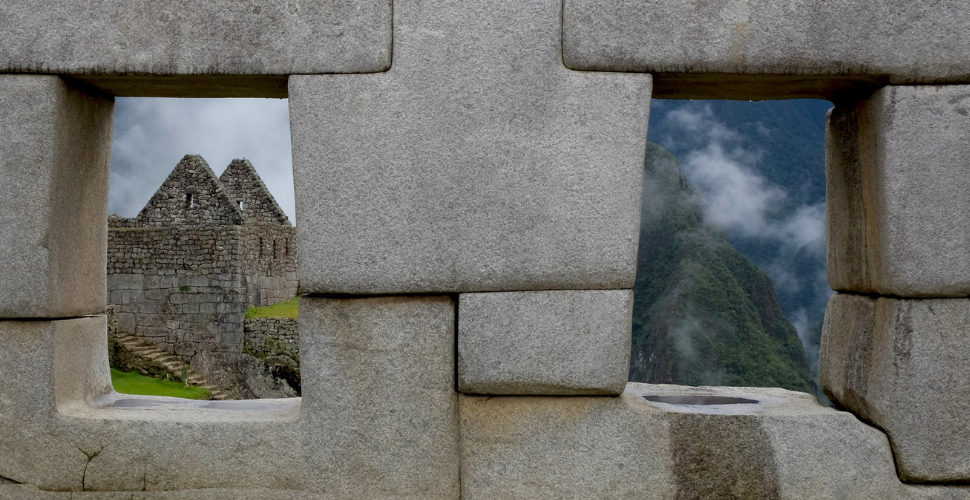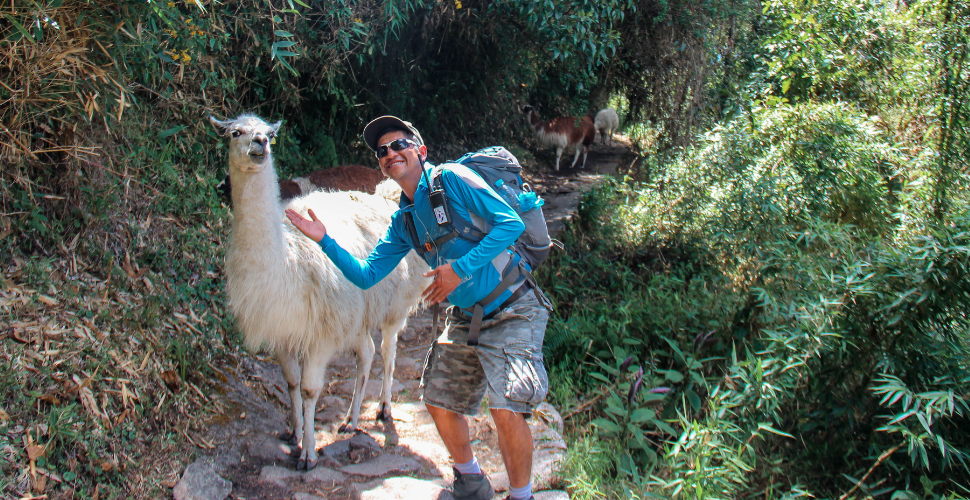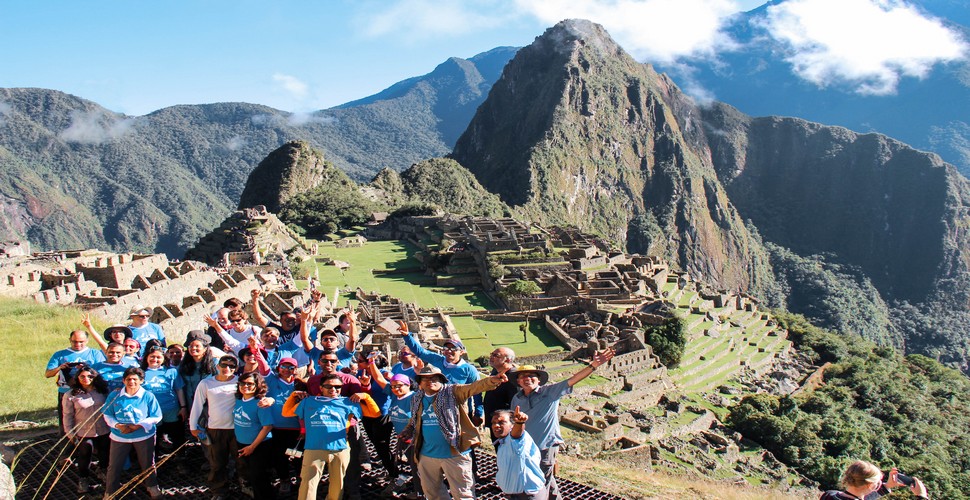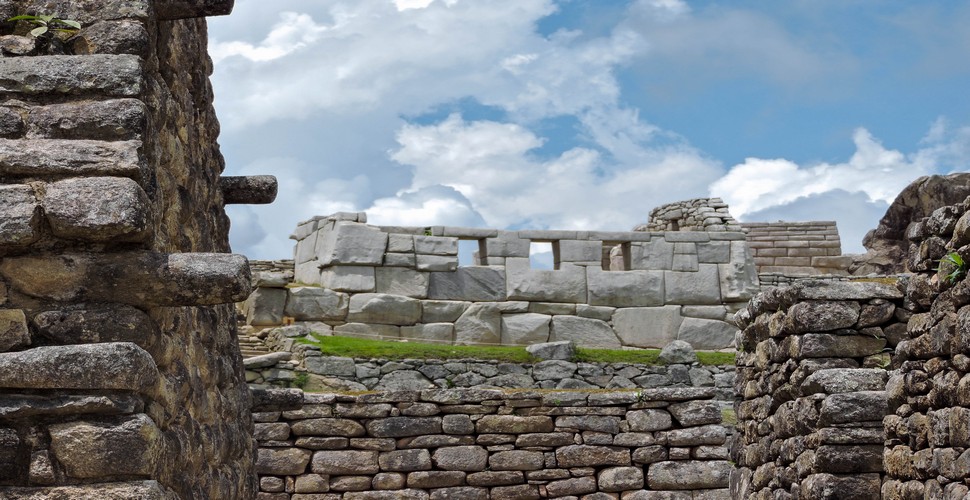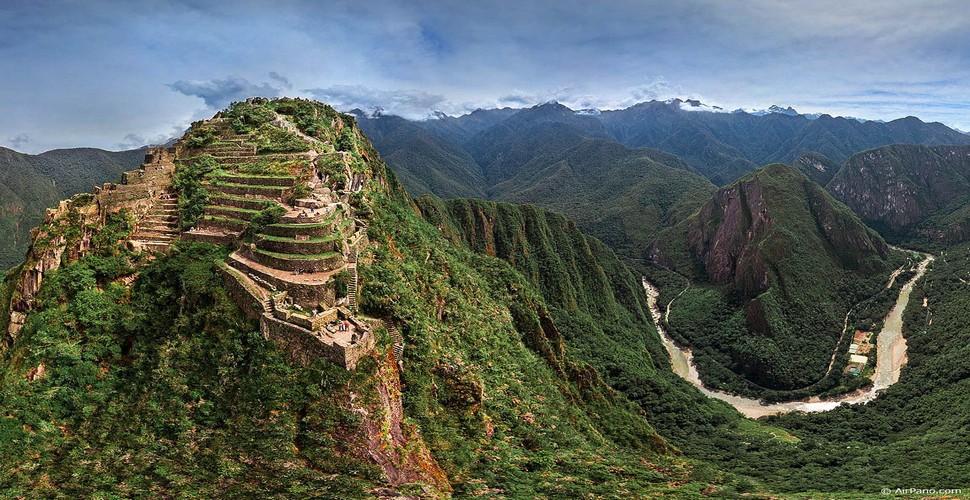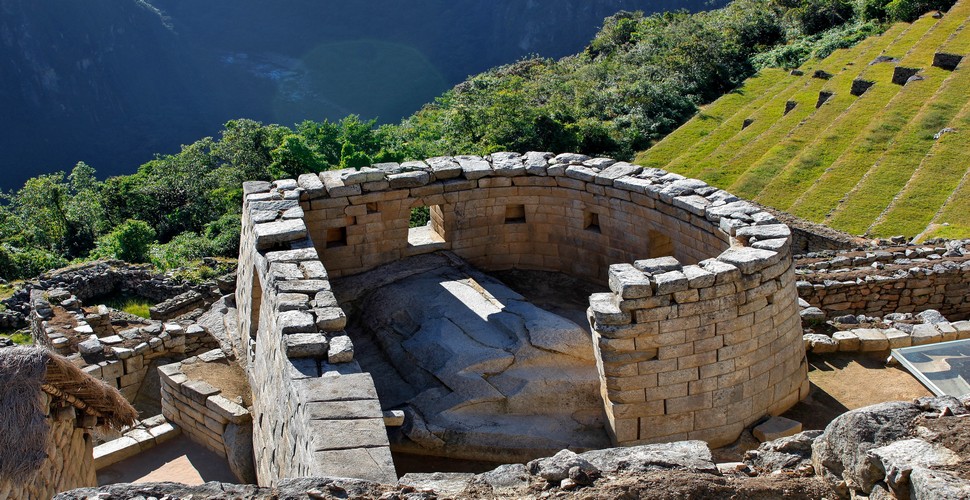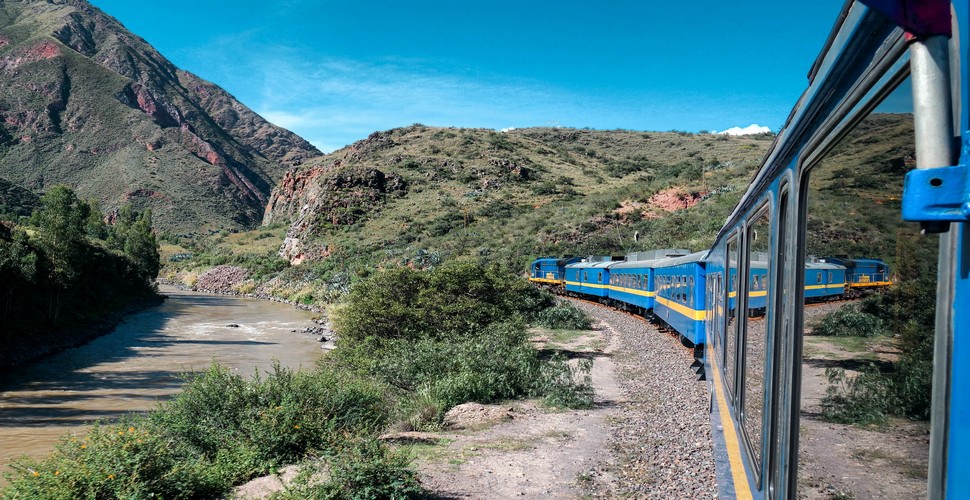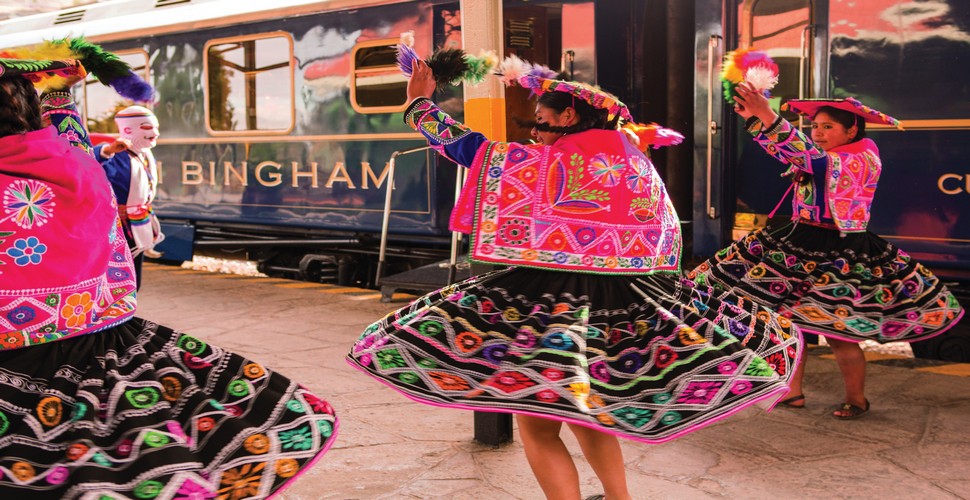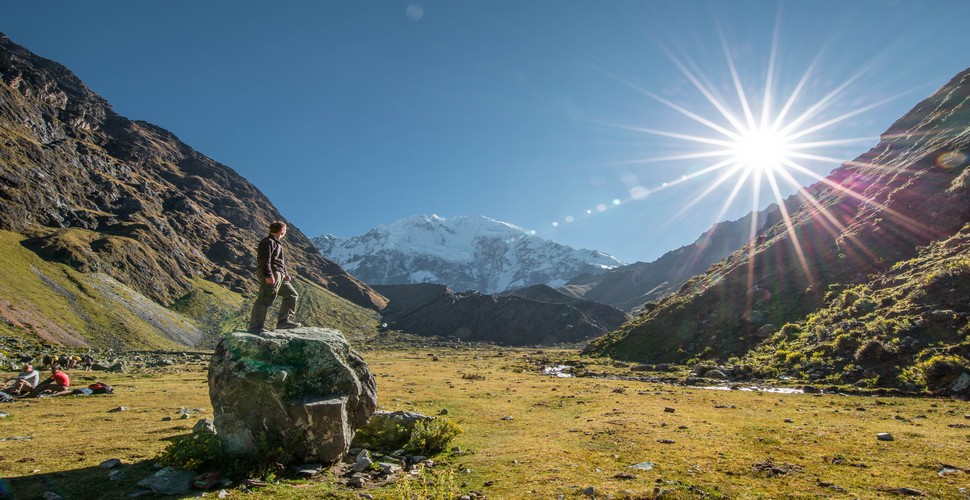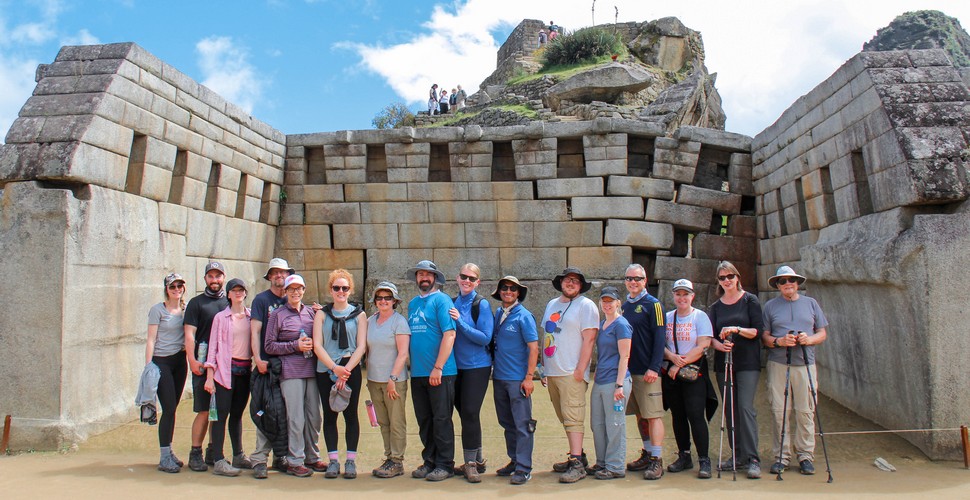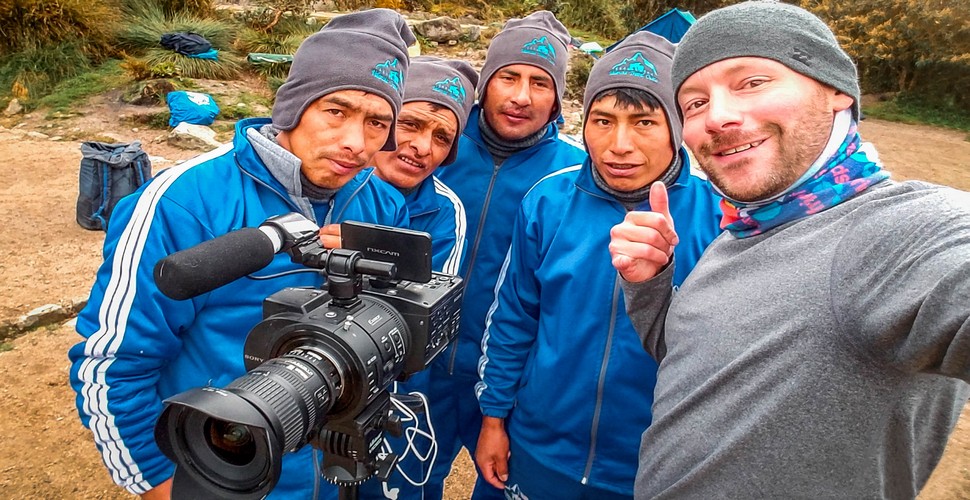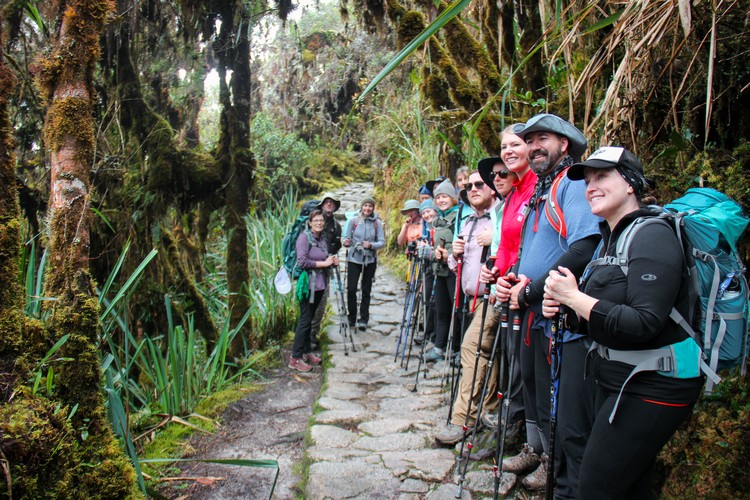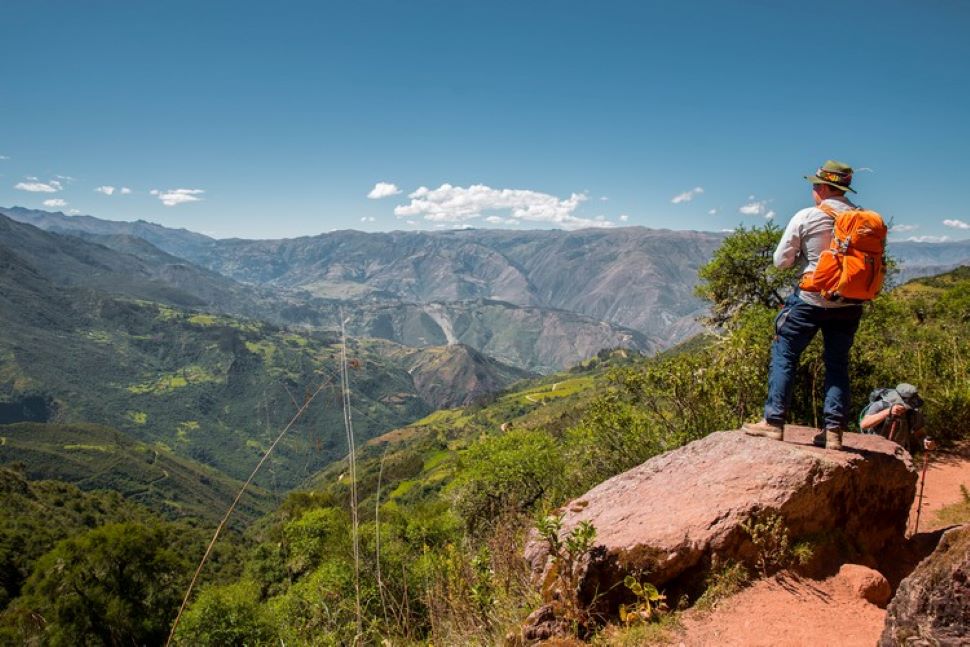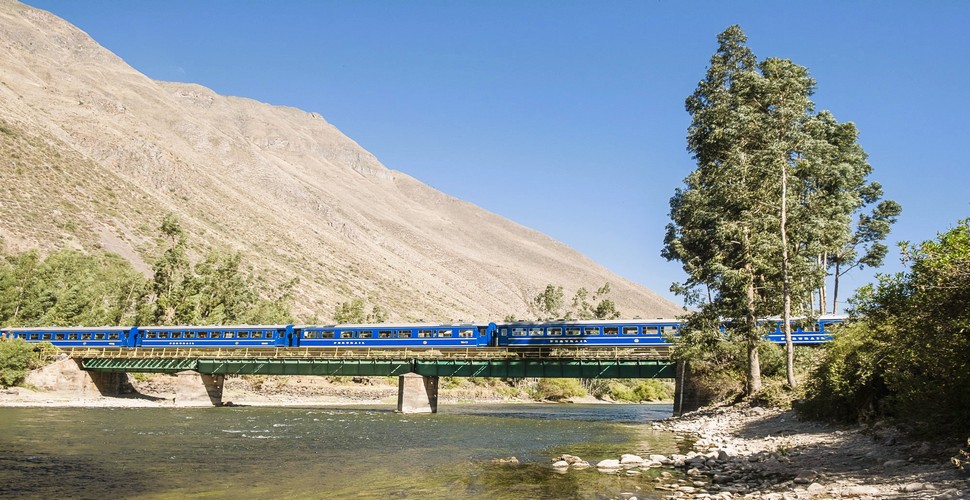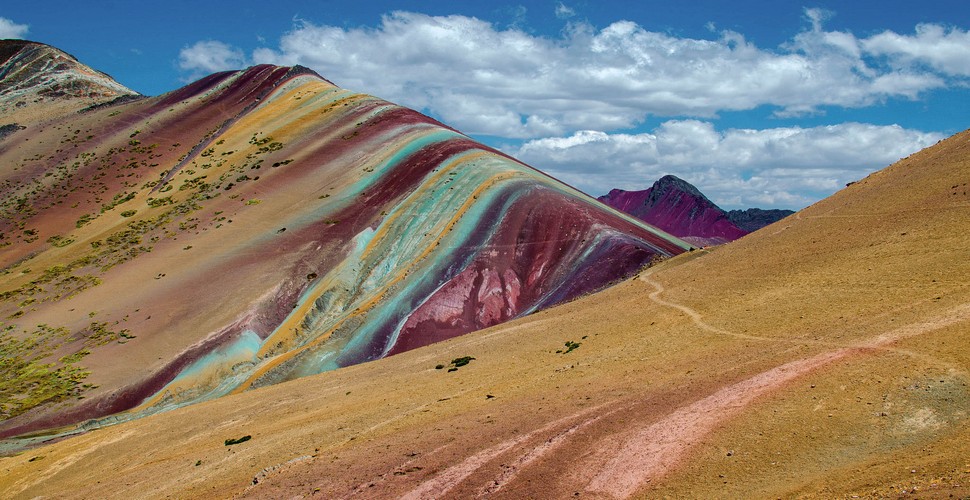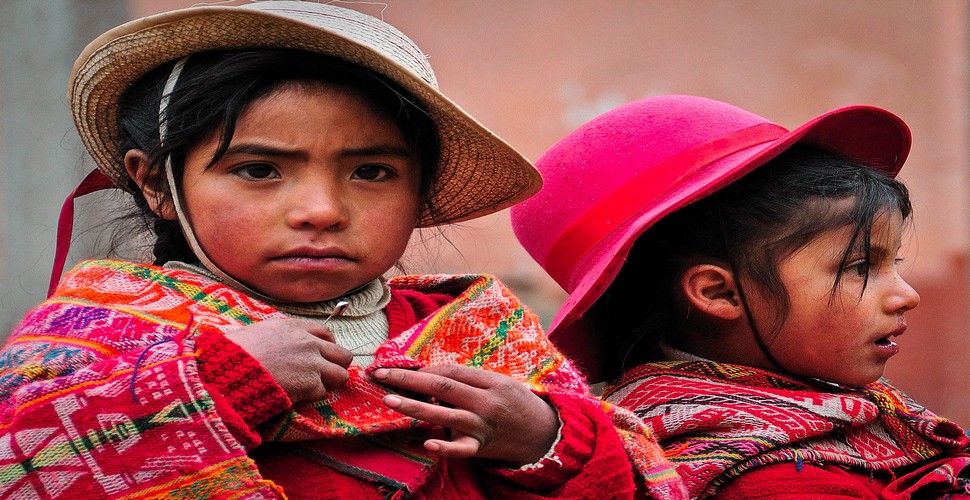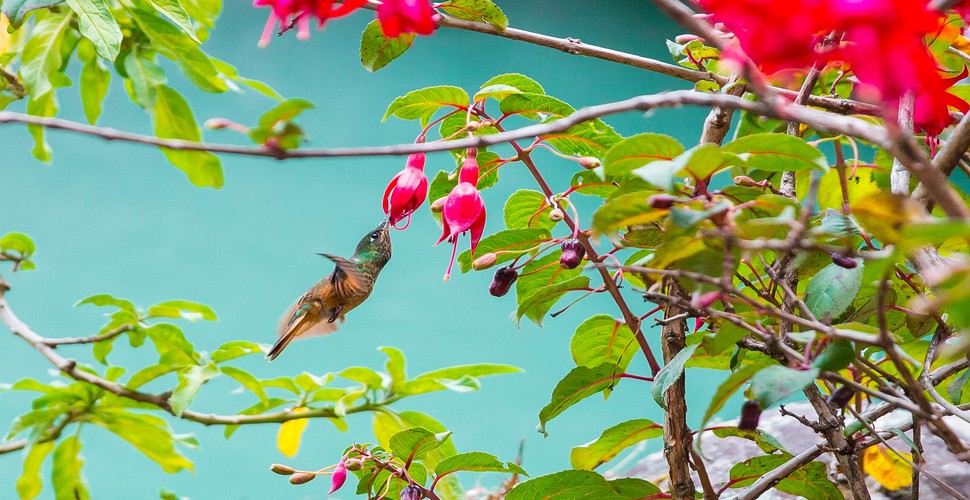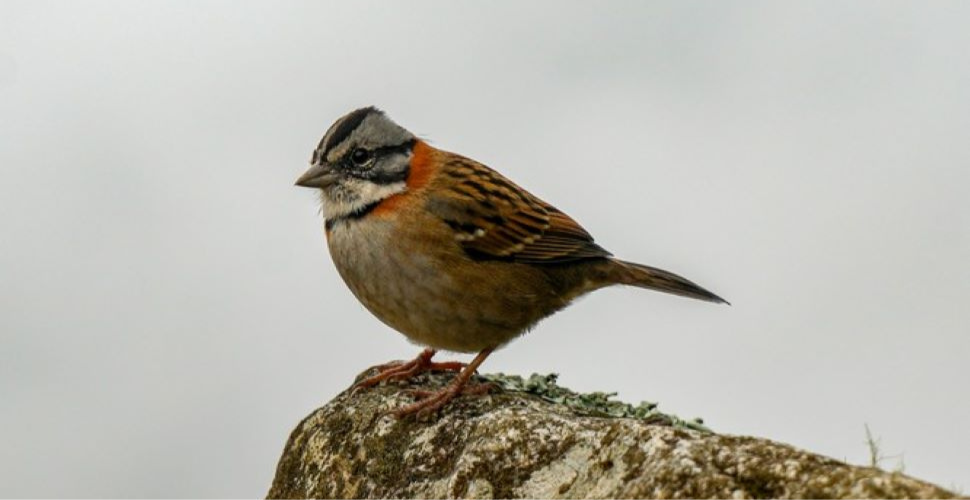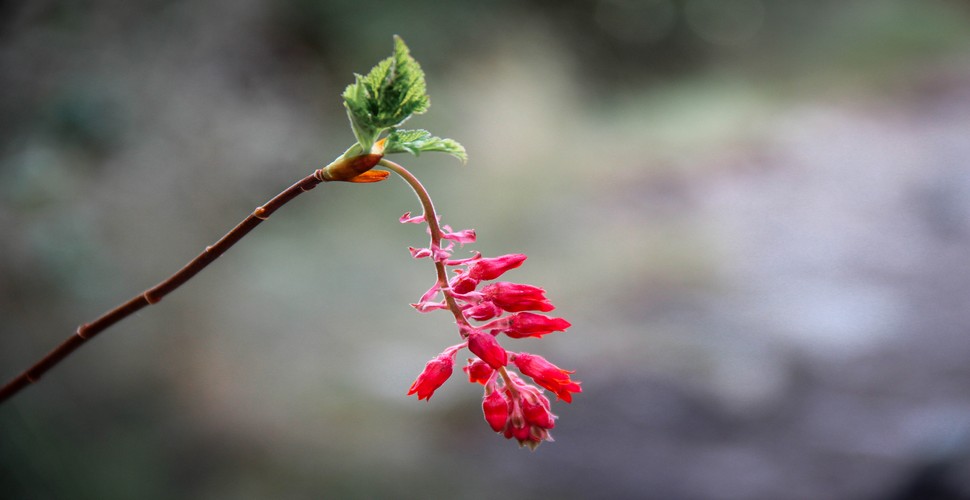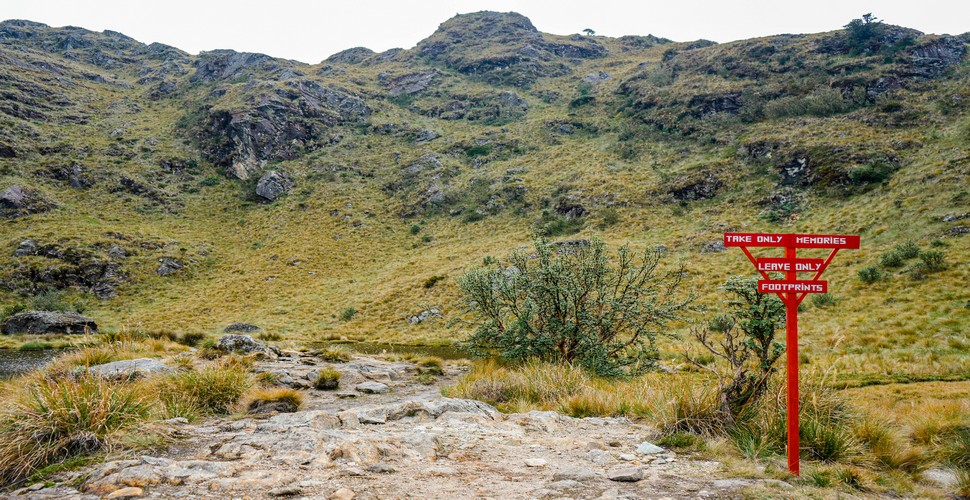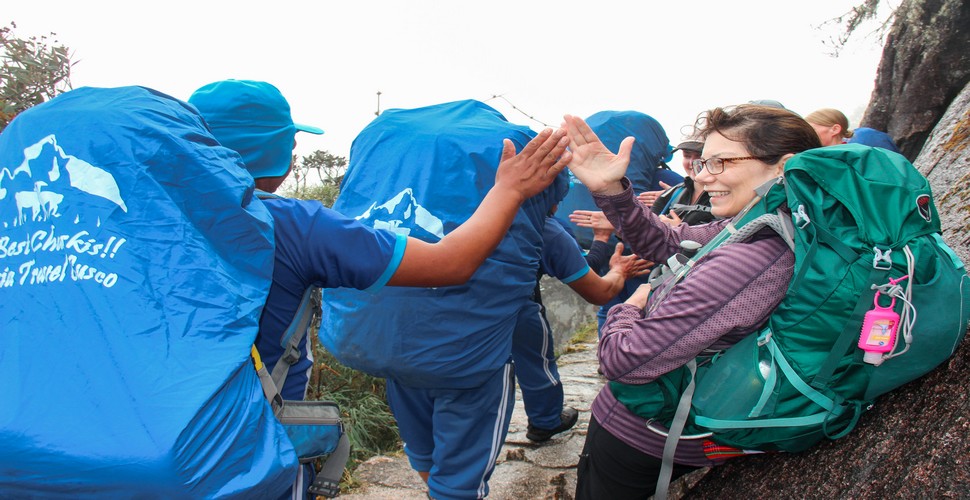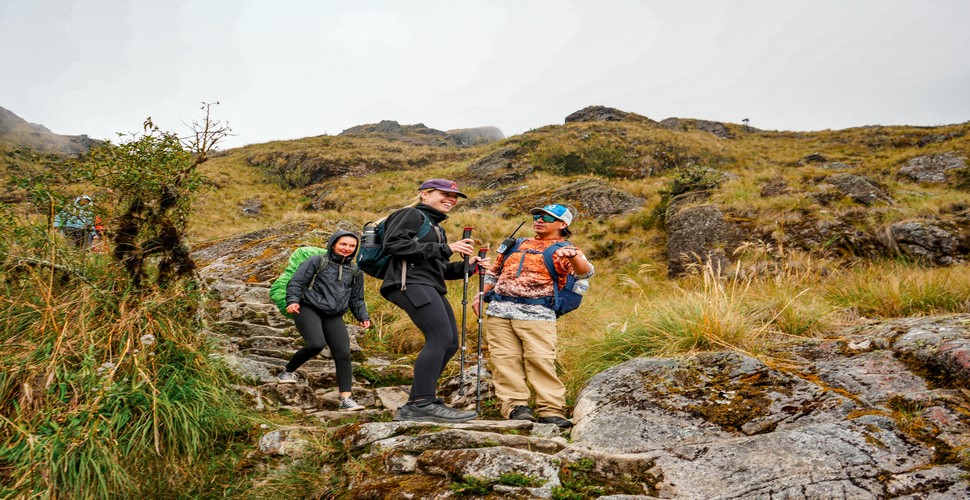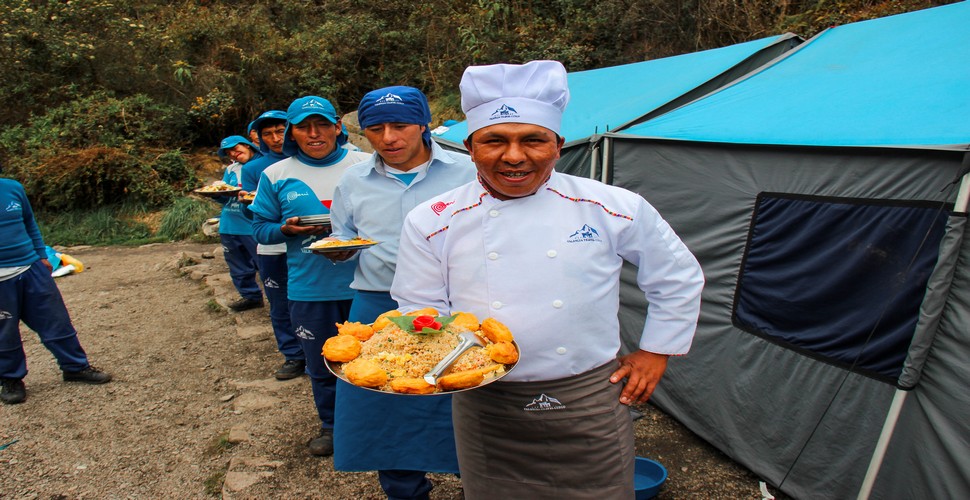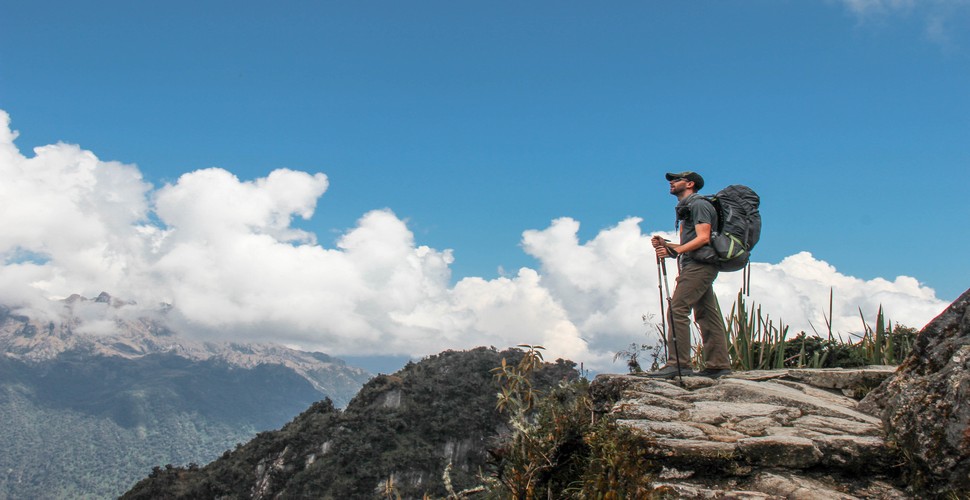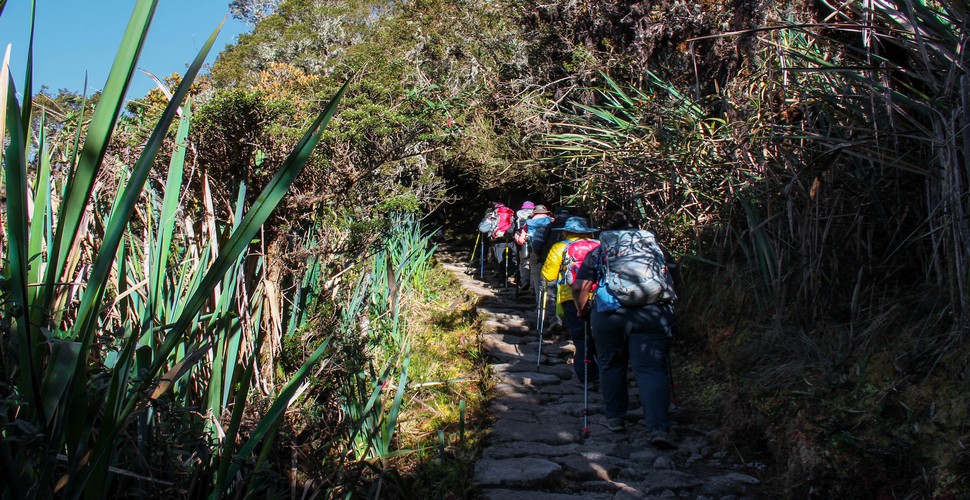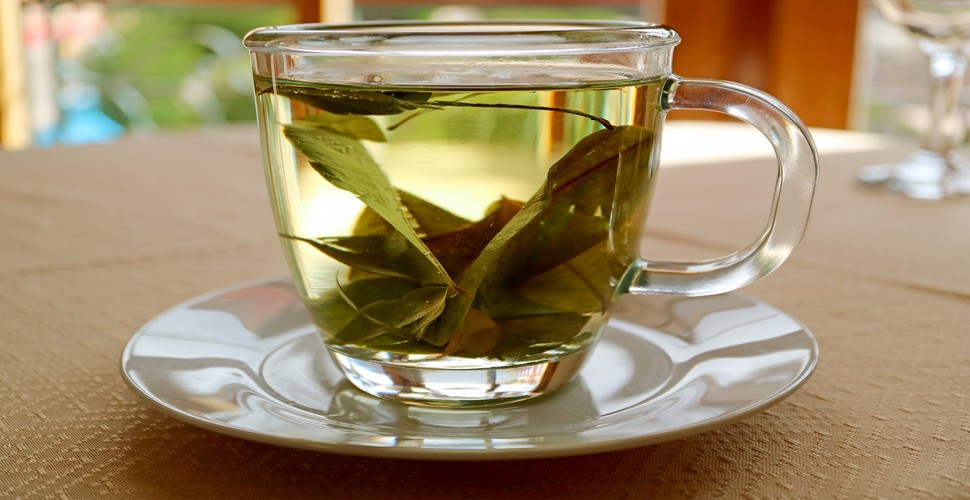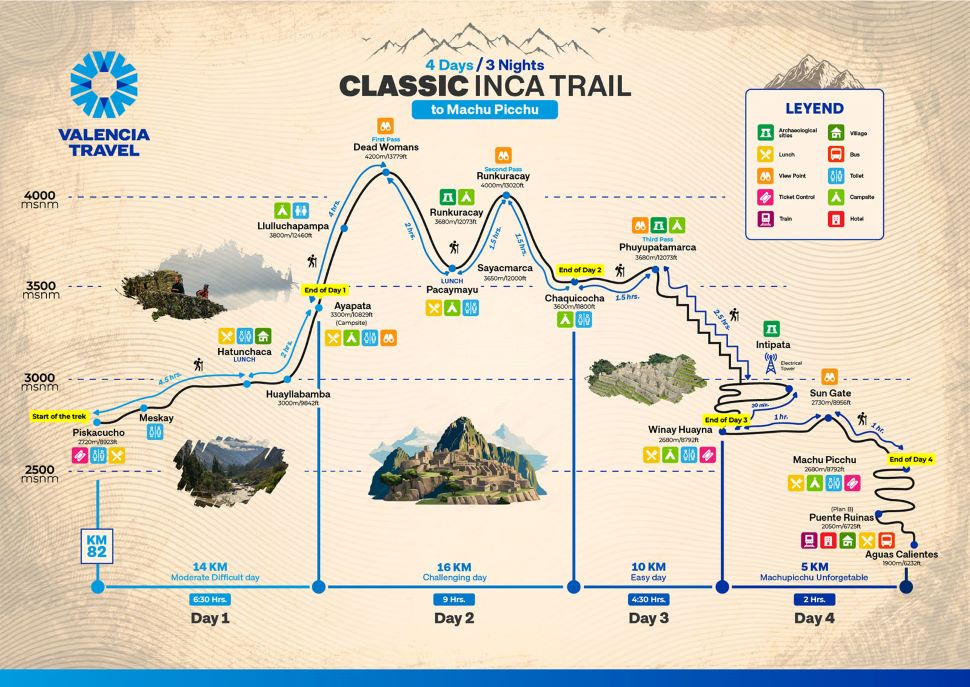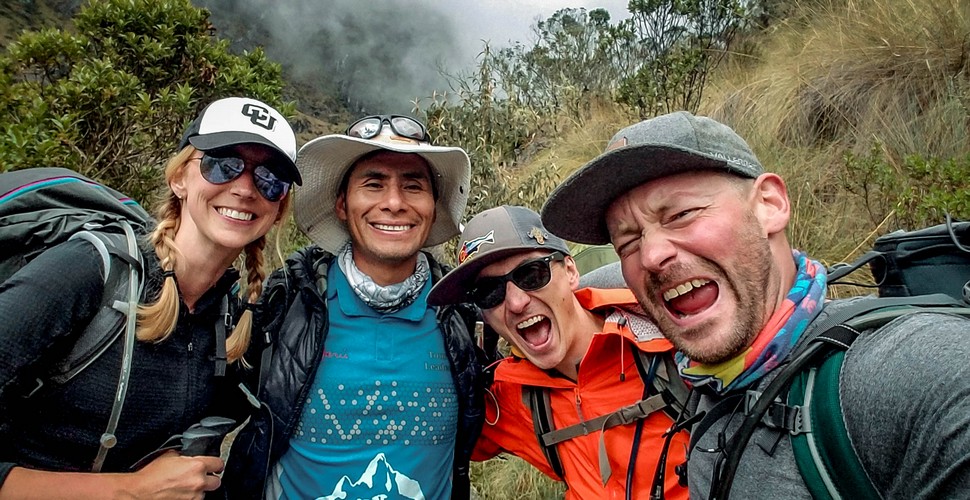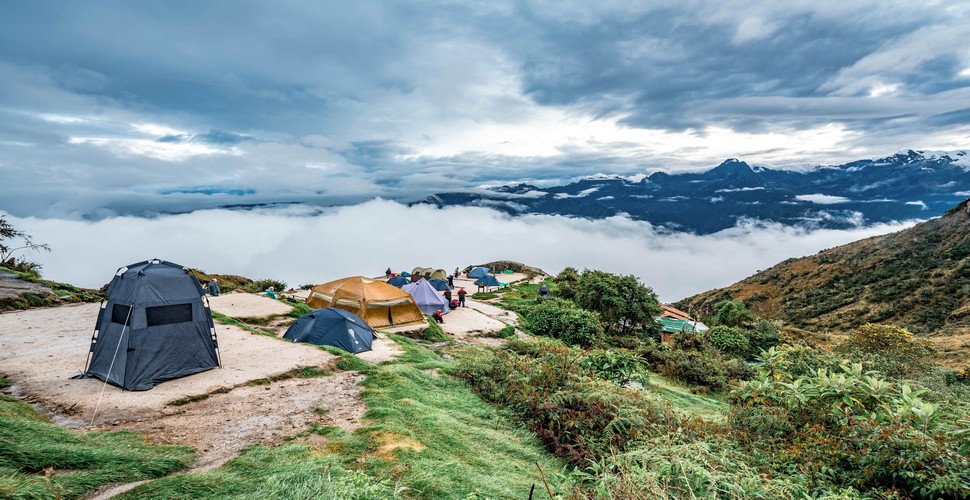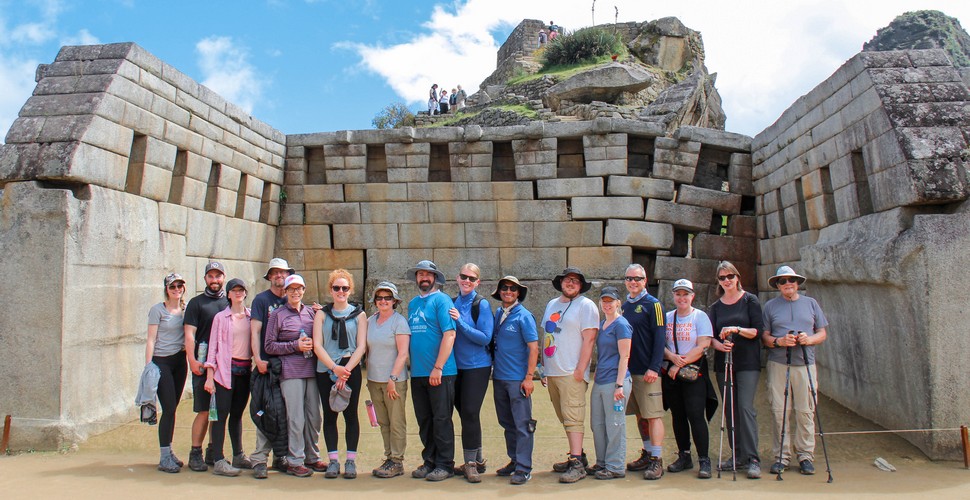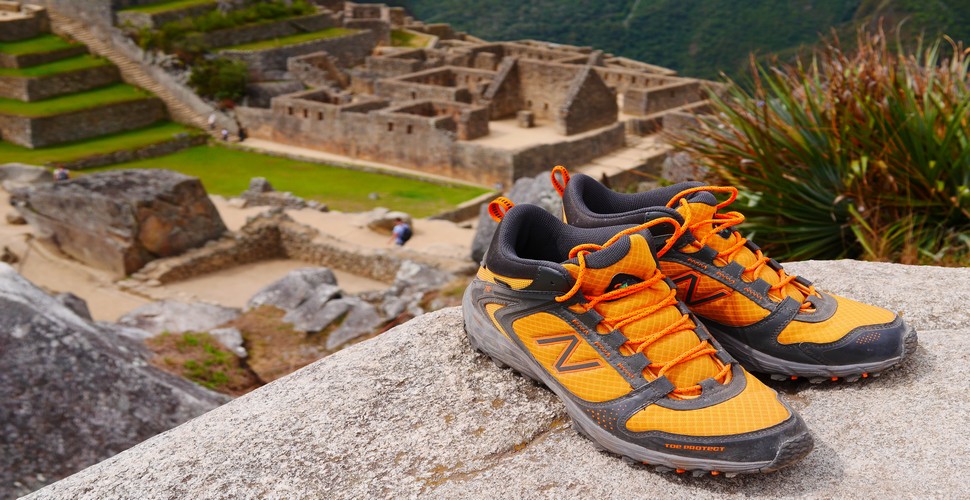
All You Need to Know About The Inca Trail to Machu Picchu
Ok, so you have probably heard of Machu Picchu, or you have learned about the incredible Inca civilization and The Lost Cities of Gold in school, but did you know that Peru is a country of mind-blowing things to discover and encounter? With its eclectic culture, rich history, jaw-dropping scenery, astounding biodiversity, delicious food, and awe-inspiring trekking, Peru is a truly unforgettable destination that is on many travelers' bucket lists. While we are on the subject, the Bucket List Peru Trek - The Inca Trail trek to Machu Picchu, is one of the most iconic trekking trails in the world! Here is some important information about The Inca Trail Hike to Machu Picchu. We will answer the most frequently asked questions about hiking to Machu Picchu, how to prepare for The Inca Trail, how to secure Inca Trail permits, and in general, what to expect on the once-in-a-lifetime Inca Trail hike.
A Complete Guide For The Inca Trail to Machu Picchu
Machu Picchu Temple View
Firstly, it is important to know that the Inca Trail Hike is not the only trek to Machu Picchu. There are a number of stunning treks to Machu Picchu to hike in the Machu Picchu region, that will allow you to reach the Inca citadel. However, the Inca Trail, either the Classic Inca Trail or the shorter Inca Trail Express, are the ONLY treks that hike directly to Machu Picchu and enter through the Sun Gate. The original entrance to the Machu Picchu citadel. All of the other treks to Machu Picchu will take you to the town of Aguas Calientes, which sits below Machu Picchu. Trekkers, day trippers, and generally most visitors will then take the shuttle bus up to Machu Picchu from Aguas Calientes. These alternative Inca Trail treks are also spectacular and were often used by the Incas, however, it is the Classic Inca Trail that was used by the elite ruling class of the Inca Empire, to arrive at the Machu Picchu citadel. This is the reason why the original Inca Trail is so special.
Inca Trail Trekker and llama!
In our guide, you will learn all about The Classic Inca Trail Trek to Machu Picchu and how you can hike the Classic Inca Trail on your Peru tour package. We will explain the ins and outs of the Inca Trail so you can make the most out of your Inca Trail Trek and Machu Picchu Visit. Join us on a journey of discovery concentrating on this magnificent Inca Trail to Machu Picchu!
All About Machu Picchu
To understand the appeal and magical quality of Machu Picchu, we must first uncover the history, meaning, and importance of Machu Picchu. This ancient mountain citadel in Peru was once the heart of the Inca Empire which covered The Andean region of Ecuador, Colombia, Peru, Bolivia, Argentina, and Chile. Located at an altitude of nearly 2430 m/8000 ft in a region of Peru where the Andes meet the Amazon Rainforest, Machu Picchu is now one of the most visited archaeological sites in all of South America. Inside the Machu Picchu Citadel there are some important temples and landmarks, here are the main sections of Machu Picchu.
Valencia Travel Group Arrive at Machu Picchu!
Main Landmarks In Machu Picchu
Temple of the Sun
The rounded wall of the tower of The Temple of The Sun was built on a large ceremonial stone that forms the base. This temple was used to honor Inti, the Sun God who was worshipped by The Incas. Sunlight pours in through the eastern-facing windows during both winter and summer solstice. The Temple of The Sun at Machu Picchu is an excellent example of the Inca´s advanced knowledge of astrology, astronomy, religion, and architecture!
The Intihuatana
"Intihuatana", is the Quechua name of this stone in Machu Picchu and means “hitching post of the sun”. It is found in the "Urban Sector" of the Machu Picchu citadel. It is thought to have been used as a sundial or astronomic calendar. The 2-meter-high slab of stone is marked by a protruding tab that points to the magnetic north. The Incas would have been able to track the movement of the sun and the seasons by using this remarkable stone. The longest shadow appears during the winter solstice on the 21st of June in the southern hemisphere, allowing them to determine their agricultural calendar and ritualistic activities.
The Temple of the Three Windows
Among the many places to see in Machu Picchu, one of the most important is the temple of the Three Windows, near the Machu Picchu main square. The temple of the three windows has always been a source of discussion amongst archaeologists as to its purpose. This Machu Picchu temple has three windows that are perfectly embedded into the stone, they are also perfectly symmetrical. Some Machu Picchu researchers believe there were at one time, 5 windows but the structure for the other 2 probably collapsed over time. This entire temple also had a roof over it when it was originally built, which probably collapsed also.
Temple of The Three Windows
The Temple of The Condor
The Temple of the Condor in Machu Picchu is another excellent example of Inca stonemasonry. This million-year-old natural rock formation began to take shape and the Inca skillfully shaped the rocks into the outspread wings of a condor in flight. On the floor of this Machu Picchu temple, is a rock carved in the shape of the condor's head and neck, completing the figure of this three-dimensional Andean Condor, one of The Inca deities. Archaeologists at Machu Picchu believe that the head of the condor was used as a sacrificial altar by the Incas
Huayna Picchu
Huayna Picchu, which means young mountain, inside Machu Picchu is the conical mountain in most Machu Picchu photos. It is one of the 2 mountains you can scale inside Machu Picchu, the other being Machu Picchu Mountain (See below). Though a steeper and hair-raising hike, the physically fit should definitely take the opportunity to trek it to witness a spectacular view of Machu Picchu from a completely different angle. Vertigo sufferers may want to consider The Machu Picchu Mountain if they want to hike as Huayna Picchu has a narrow trail with sheer drops and even ladders at a certain section. The views of the surrounding valley however are absolutely mind-blowing!
Huayna Picchu Mountain
Machu Picchu Mountain
Unlike Huayna Picchu, which is a very popular climb, fewer visitors take on the challenge of climbing Old Mountain - Machu Picchu Mountain in Quechua. This means that you will usually have this incredible mountain to yourself. The view of Machu Picchu from the Machu Picchu Mountain is unparalleled. Huayna Picchu is reduced to a mere bump from this height. The view from Machu Picchu Mountain also offers you the opportunity to put into perspective the amazing location of the Inca citadel of Machu Picchu. The winding Urubamba River crashes at the foot of the mountain and passes through the middle of the peaks, allowing for otherworldly vistas.
The Inca Bridge In Machu Picchu
The Inca Bridge in Machu Picchu is a Man-Made bridge made of two tree trunks that cross a 5-meter gap on a narrow path along a cliff face. The stone wall was constructed by the Incas to support the Inca Trail, with the valley floor situated approximately 580 meters below. On both sides of the bridge, stone steps jut out from the wall so that the handmade bridge can be rebuilt. The Inca bridge served as a protective measure for an alternative entrance route to Machu Picchu, via the western side of Machu Picchu Mountain. In contrast, the commonly used entrance through the Sun Gate for those hiking The Inca Trail navigates around the eastern side of the mountain. If any intruders attempted to enter via this alternative trail, the Inca guards could easily remove the log bridge, making the trail impassable. Additionally, the bridge could function as a hidden entry point for the Inca army into Machu Picchu.
Important Sites Inside Machu Picchu
What Was Machu Picchu?
Machu Picchu means "Ancient Mountain" in Quechua, one of Peru’s indigenous languages, especially in The Andes. Machu Picchu evolved from a mountain summit to a sacred site during the rule of the Inca Empire in the middle of the 15th century. Found just 75km / 45 miles from Cusco City, the Inca Trail to Machu Picchu today, is a magnet for adventurous travelers, though it was once a remote site that allowed the Incas to hide from any possible invaders. Many stone steps some of which were cut into over 100 impressive terraces, lead up to an expansive stone citadel, within it were plazas, sacrificial areas, and an elaborate irrigation system. There was also a living sector for Inca royalty and guardsmen, servants, and an entourage of many more. While it hasn’t been established if Machu Picchu served as a seasonal retreat or long-term residency for the Incas, the site did feature the ancient culture’s core elements of agriculture, spirituality, astronomy, and a generally harmonic city.
One of the most impressive features of Machu Picchu is that after centuries of heavy rains and frequent earthquakes, Machu Picchu remains in an excellent state of preservation. Inca engineers and architects insisted on building a sturdy foundation and tiered farmlands to prevent landslides. The Inca stonemasons carved enormous granite stone in such a precise way that they could be pieced together like a jigsaw, without mortar or any sort of fixing agent. This is why the Inca civilization continues to be a topic of wonder for modern archaeologists and history buffs, to try and uncover the facts of this incredibly advanced society.
Temple of The Sun in Machu Picchu
The History of Machu Picchu
Machu Picchu in its prime was truly fit for an Emperor! It is believed the citadel was built for the Inca Pachacutec who ruled from 1438 to the early 1470s. The ninth Inca ruler, Pachacutec would begin an era of conquest that marked the advance of the Inca Empire called Tawantinsuyu, the largest empire in all of The Americas at the time.
Archaeologists estimate that the construction of Machu Picchu began around 1450 and took decades to complete. Just a century later, however, The Spanish Invaders began to gain ground in what is today is called the Cusco region. Remote and way off map, Machu Picchu was perfectly hidden from the Spanish invaders, however, Machu Picchu was still abandoned by its people who sought safety. In 1911, American explorer Hiram Bingham arrived in the Sacred Valley and followed the Urubamba River all the way to Machu Picchu. He actually thought it was the mysterious “Lost City of Gold” called Vilcabamba. Though overgrown with dense cloud forest, Machu Picchu was not a secret to locals who continued to grow their crops there. During the past 50 years, Machu Picchu has been given the title of Peruvian Historical Sanctuary (1981), A UNESCO World Heritage Site (1983), and one of the New Seven Wonders of the World (2007).
A History Of Machu Picchu
Weather on the Inca Trail
The weather on the Inca Trail to Machu Picchu generally depends on the season. Generally speaking, April to September is the dry season, November to February is the rainy season, and March and October are considered the shoulder seasons – which means the climate can be unpredictable. Peru is in the southern hemisphere, so when it's summer in The USA and Europe, it is winter in Peru. June to August are the peak winter months in Peru, and November to February is summer. However, the rainy season in the Andes and the Machu Picchu region actually falls during the summer months, so although there are warmer temperatures, the weather is wet along The Inca Trail trek to Machu Picchu. The weather patterns have become more variable in the past few years, so we recommend that you prepare for sun and rain all year round. As far as temperatures go on the Inca Trail, they are generally consistent throughout the year. Mornings and evenings are always cold. Make sure you bring a fleece jacket for the mornings and a down jacket for the evenings. Once the sun comes up you should be comfortable hiking the Inca Trail to Machu Picchu in short sleeves. Long pants are encouraged to help from the mosquitos which can be an issue in Aguas Calientes and at Machu Picchu.
Rainfall and Temperatures Along The Inca Trail
The Different Ways to Get to Machu Picchu
The most famous attraction in Peru, by far is Machu Picchu, which attracts visitors from all over the planet. This magnificent archaeological site sits on an isolated mountain ridge where the Andes Mountains meet the Amazon Rainforest. For your Peru Machu Picchu trip, one of the most iconic archaeological sites in the world, and for any Machu Pichu vacation package, you will need to plan ahead, as it is located in a remote area of Peru. Here are the best ways to get to Machu Picchu.
Getting to Machu Picchu By Train from Cusco
Cusco to Aguas Calientes: Start your Peru Machu Picchu trip by flying into Cusco, the nearest major city to Machu Picchu. From Cusco, take a train to Aguas Calientes (also known as Machu Picchu Pueblo). Several train companies, such as Peru Rail and Inca Rail, offer daily services. The train ride to Machu Picchu through the sacred Valley is a scenic experience in itself.
For travelers who are short on time and otherwise not able or willing to trek to Machu Picchu, most travelers on their Machu Picchu Tours will arrive in Aguas Calientes by train, which is the ideal solution. It is also the only option for travelers to avoid an overnight stay in Aguas Calientes altogether and instead arrive in the morning from either Ollantaytambo or Poroy (Cusco).
The prices for train tickets to Machu Picchu differ depending on the advanced time of booking, the time slot chosen for the day of travel, and the type of train you prefer.
Train to Machu Picchu
Types of Train to Machu Picchu:
The Expedition Train
The expedition train is the tourist class of train to Machu Picchu. The train is all seated and departs from Ollantaytambo or Poroy. The Expedition Train is the most economical option for tourists heading to Machu Picchu. Service is simple, and light snacks and drinks are available for purchase. Air conditioning and heating ensure a reasonable temperature, and luggage is stored securely in the racks placed above the seats.
The Vistadome Train
The Vistadome train comes with large panoramic windows and skylights through which passengers can enjoy the stunning views of the Sacred Valley. Trains depart for the three-hour train journey from Poroy, a small village outside Cusco, or the 1:30-minute ride from Ollantaytambo several times a day.
The Belmond Hiram Bingham
The Belmond Hiram Bingham offers a luxury level of service with the inclusion of gourmet food, drinks, and on-board entertainment. Running only between Poroy and Machu Picchu, the service offered during the three-hour train is reminiscent of luxury exclusive train travel on the Orient Express, with all the creature comforts thrown in.
Luxury Train to Machu Picchu
Hiking To Machu Picchu
The Classic Inca Trail
The Inca Trail to Machu Picchu is the most authentic and original Inca trail to Machu Picchu and one of the most iconic trekking experiences in the world. If your dream is to hike Inca Trail to Machu Picchu, then you will be hiking an extensive Andean Road system built by the Incas called the Qapaq Ñan, spanning 30,000 km and was declared a UNESCO world heritage site in 2014. With a length of 45 km and reaching an altitude of 4,200m in elevation, the Inca Trail to Machu Picchu passes through several types of Andean environments, including cloud forest and the Andean Mountains, with many Incan ruins along the way. The Inca Trail is the only trail that actually reaches the Sun Gate, or “Inti Punku”, the historic entry point to Machu Picchu. From this point, hikers can enjoy a spectacular view over the sacred city. Hikers are not permitted to trek the Inca Trail without a guide and MUST book through an authorized operator like Valencia Travel. The Inca Trail books out months in advance, especially in high season. See our guide about Inca Trail permits
Inca Trail KM 84
The Short Inca Trail
Arriving at Machu Picchu on the two-day Inca Trail consists of a stunning train journey through the Sacred Valley to access Km 104 of the Inca Trail hike. You will disembark the train around 30 minutes before the town of Aguas Calientes at what will appear to be the middle of nowhere, called the stop KM 104. From here, the short Inca Trail hike will take you into the Andes Mountains and will ascend up, around, and down this mind-blowing mountain range. It is an intermediate hike that can take anywhere from 5-8 hours. There are plenty of steep climbs and tight curves, but they are all worth the stunning views from the top of the world in the Peruvian Andes. This shorter option joins the classic Inca trail on its day 3 allowing you to trek into Machu Picchu through the Sun Gate, but with no camping involved and missing out on the toughest ascent over Dead Woman´s Pass. After the first day of trekking, you will spend the night in Aguas Calientes in a hotel, and you will have the all-important Machu Picchu visit on the second day.
Alternative Hikes to Machu Picchu
A number of different hikes have been adapted with Machu Picchu being the final destination, via of course Aguas Calientes. These include the magnificent 4-day Lares trek, The 9-day Choquequirao Trek, not for the faint-hearted, and The Moonstone Inca Quarry trek which takes 5 days. Whichever your chosen option, the prize at the end of the day is the magnificent Machu Picchu!
Salkantay Trek
If there are no permits for the Inca Trail to Machu Picchu, then the second favorite option is the Salkantay Trek to Machu Picchu. The trek offers a similarly diverse trekking experience with a mix of different terrains, ranging from snowy peaks to tropical areas. The biggest highlight of the 55-km trek is crossing the Salkantay Pass at a lung-bursting 4600m elevation with spectacular vistas into the valley below and views of the surrounding snow-capped peaks. Starting in Mollepata or Soraypampa, the Salkantay Trail finishes in Aguas Calientes, where hikers stay for the night before visiting Machu Picchu the next day. Officially renamed Machu Picchu Pueblo, Aguas Calientes is the town closest to Machu Picchu and the principal access point through which most visitors must pass either on their way to the sacred city.
Salkantay Trek
By Bus and Hike from the Hydroelectric Station to Machu Picchu
An economical option is to take a bus from Cusco to the Hydroelectric Station, which takes around 6-7 hours. From there, you can hike along the train tracks to Aguas Calientes, which takes about 3 hours. This option is more time-consuming but cheaper than taking the train. Dozens of minibusses take passengers to nearby Hidroelectrica, a hydroelectric power station at the end of a long and narrow dirt road in the Urubamba Valley. Hidroelectrica is connected to Aguas Calientes via a train line, but many people prefer to complete the route on foot instead.
Machu Picchu Tour Package
Many tour operators such as Valencia Travel offer comprehensive Machu Picchu Tour Packages for your Peru trip, which include transportation, accommodation, entrance tickets, and guided tours. This can be a convenient option for those who want a hassle-free experience. This way you can forget about all the logistics for your Machu Picchu vacation package and concentrate on the magnificent scenery and awe-inspiring archaeological site! Visiting Machu Picchu is a unique and awe-inspiring journey that combines history, culture, and natural beauty. It's a place that appeals to travelers of all interests and backgrounds, making it a must-visit destination for those exploring Peru and South America. Whether you trek, train, or bus to Machu Pichu on your Peru holiday package is however your decision!
Machu Picchu Tour Packages
The Different Inca Trail Hikes to Machu Picchu
One of the most iconic treks in the world can be found in Peru! The Inca Trail hike is the trek of all treks and if you have heard about any trek in the world, it is likely to be the Inca Trail Trek to Machu Picchu. Combining Andean valleys, high mountain passes, tropical cloud forests, magical archaeological sites, and pristine nature, as you hike the famous Inca Trail to Machu Picchu you are guaranteed to be filled with awe and wonder.
The Classic Inca Trail – 4 Days
If you hike the 4 day Classic Inca Trail to Machu Picchu, then there are several advantages including seeing other, lesser-known archaeological sites along the way up that are not visible from the train. Trekking through the different landscapes along the Inca Trail hike, ranging from sandy trails to snowy passes then descending into the cloud forest is a trekker's dream. The Inca Trail is a bucket list item and people come in their droves to hike this magical trail to Machu Picchu every year for its stunning scenery and the ultimate bragging rights when they go back home.
Trek Along The Inca Trail to Machu Picchu – 7 Days
The Incas built a network of roads that was around 40,233 km/25,000 miles long. This Inca Trail Road Network once stretched into Ecuador, Chile, Bolivia, Argentina, Colombia, and of course, Peru, with roads connecting Inca settlements and trading centers across all of South America. Our 7 Day Inca Trail Hike will begin in the Inca capital of Cusco, where you can acclimatize for a few days. We will then take you to the trailhead of The classic Inca Trail, where you will begin the 4 day hike to Machu Picchu.
Porters Learning Photography!
The Classic Inca Trail Premium – 4 Days
Much of the path along the famous Machu Picchu Inca Trail Hike is an original Inca road, showing that ancient Inca engineering is just as durable as modern-day roads. Many historians believe that this Inca trail was built as a pilgrimage route to honor Inti - The Inca Sun God, so you are walking a holy path! Today, you can enjoy your mystical journey in private so you can have the full attention of your guide, and immerse yourself in the energies of ancient trails, spectacular scenery, and pristine nature as you hike to the most famous ancient site in the world- Machu Picchu.
The Classic Inca Trail to Machu Picchu – 5 Days
The 5 day Inca Trail Trek to Machu Picchu follows the same route as the Classic Inca Trail, but you have a richer, slower, and more exclusive experience. The 5 day trek means that you stay at the lesser-visited campsites along the Inca Trail and hike at a slower pace, so you can take in the wonderful scenery and nature all around you. You get more time to acclimatize and cross the high pass a day later. You have also more time to enjoy the Inca sites and you get to visit Machu Picchu twice! This option is perfect for families who do not want to feel rushed on their Inca Trail! (see more information about a Family Inca Trail here.)
The Short Inca Trail to Machu Picchu – 2 Days
Don’t have time for the full Inca Trail hike? This is why the 2-day Inca Trail hike is perfect for those short on time (or energy!) The Short Inca Trail is also perfect for families with small children who don´t want to miss out on The Inca Trail Experience! (see more information about a Family Inca Trail here.) Our Short Inca Trail trek to Machu Picchu is 11 KM/6.8 Miles from beginning to end, which is hiked on the first day. You’ll get a taste of the Classic Inca Trail and visit important archaeological sites as well as enter Machu Picchu through the Sun Gate. On the second day, after a night in a hotel in Aguas Calientes, we will visit the magnificent Machu Picchu….. that sounds easier, doesn’t it?
Inca Trail Express
The Inca Trail Express to Machu Picchu – 5 Days
The Inca Trail Express is the Short Inca Trail trek to Machu Picchu. The difference here is that we spend 2 days acclimatizing in Cusco and get to see the Cusco sights before we head out on our 2 day trekking trip to Machu Picchu. After the short Inca Trail and the magnificent Machu Picchu, we head back to Cusco where you will have your hotel included.
Salkantay and Short Inca Trail Trek - 6 Days
This Salkantay Trek and Inca Trail is unique as it joins up with the Short Inca Trail Trek to Machu Picchu! This way you can have the best of both worlds. You will trek through the stunning scenery of the Salkantay Trek and climb the pass of the sacred Apu of the Incas -Salkantay. You will experience some of the main highlights of the Classic Inca Trail, including the beautiful Wiñay Wayna archaeological site with its spectacular series of agricultural terraces, as well as Inti Punku, Machu Picchu’s famous Sun Gate. And then, of course, there’s Machu Picchu itself, one of the most sublime sights on the planet.
Views from The Salkantay Trek
Salkantay Trek & Inca Trail to Machu Picchu – 7 Days
This opportunity to combine 2 of the most iconic treks in Peru that combine the magnificent scenery of The Salkantay Trek and the wonderful archaeological sites along the 4 day Inca Trail trek to Machu Picchu is the perfect way to experience all aspects of trekking in Peru. It perfectly combines Mother Nature´s gifts and the magical aspects of The Inca Trail hike. Machu Picchu will still be the ultimate destination at the end of the trek as this unique trekking route will still arrive directly to Machu Picchu through the iconic Sun Gate.
Which Inca Trail is Right For You?
The Best Way to Get to Machu Picchu for Non-Hikers.
Taking The Train To Machu Picchu
If hiking The Inca Trail isn´t your “thing”, then don’t worry! You can also enjoy a picturesque and relaxing train ride to Machu Picchu on our 2 Day Sacred Valley and Machu Picchu Tour! Your first day will be spent exploring the Sacred Valley, learning about local culture as the precursor to your Machu Picchu visit! You will then head to Aguas Calientes by train, where you will spend the night. You will visit Machu Picchu the next morning for your guided tour of Machu Picchu.
Whether you are on a tight schedule, traveling with small children, or simply don’t want to hike to Machu Picchu but still want to get the most out of your Machu Picchu visit, then Valencia Travels´ tours by train are an excellent option. We will take care of all the reservations and entrance ticket purchases as well as transfers. Our team will arrange all the finer details so you can relax and enjoy your Machu Picchu visit.
The train journey to Machu Picchu is an experience all of its own. You will be astounded by the stunning scenery that the train trip to Aguas Calientes offers. You will witness the entrance to the rainforest and be blown away by the amazing vistas.
Train Tours to Machu Picchu - Perfect for Non-Hikers
Here are six tours that include the train journey to Machu Picchu including Cusco, the Sacred Valley, and in some cases tours from Lima!
- Sacred Valley and Machu Picchu by Train - 2 Days
- Machu Picchu by Train - 2 Days
- Machu Picchu - Full Day
- Machu Picchu Express - 7 Days
- Luxury Machu Picchu Express
- Machu Picchu Special - 7 Days
Train Travel in Peru
The Shuttle Bus from Aguas Calientes to Machu Picchu and Back
To take the shuttle bus up to Machu Picchu you will generally wake up early. This is to see the sunrise and have a spectacular view of Machu Picchu. Your guide will provide a 2 hour tour of the Machu Picchu citadel. Permits are required to climb either of the two mountains inside Machu Picchu, namely Huayna Picchu or Machu Picchu Mountain. You can reserve these options at the time of booking your tour. It is best to arrange those well ahead of your Machu Picchu trip. After exploring Machu Picchu, you will take the shuttle bus back to Aguas Calientes, then the return train ride back to Ollantaytambo/Poroy. You will be able to look back on your Machu Picchu visit, inspired by an ancient civilization and a brand-new perspective on life, spirituality, and travel.
The Best Ways To Get To Machu Picchu For Non-Hikers
Inca Trail Permits
Check out All You Need to Know about the Inca Trail Permits
Optional Cusco Add-Ons for Before or After Your Inca Trail Trek to Machu Picchu.
Cusco is a beautiful Andean city in Peru with a rich history and plenty of attractions to explore in its own right! If you have a few extra days in Cusco before or after your Inca Trail trek or Machu Picchu Tour Package, here are some optional add-ons and activities you can consider to make the most of your time on your Adventure Hike to Machu Picchu on the Inca Trail.
Our Pick of The Optional Add-Ons!
- Sacred Valley Tour: The Sacred Valley of the Incas is a picturesque region just outside of Cusco. You can visit towns like Pisac, Ollantaytambo, and Chinchero, exploring ancient ruins, local markets, and enjoying the spectacular countryside of The Andes. If you are struggling or trying to acclimatize before your Inca Trail trek, you should visit The Sacred Valley as it is 1000 meters lower than Cusco.Horse Riding: Enjoy horseback riding in the beautiful countryside around Cusco, with the option to visit archaeological sites such as the Temple of The Moon and Qenqo. Enjoy horseback riding through the wonderful Andean region before your Inca Trail Adventure.
- ChocoMuseo: This Chocolate Museum in Cusco offers workshops on making chocolate from scratch. It's a great activity for families or chocolate lovers.
- San Pedro Market: Explore this bustling local market on your Cusco City tour to experience the daily life of Cusco's residents. You can buy local products, sample traditional foods, and shop for souvenirs at this wonderful eclectic Cusco Market
- Sacsayhuaman and Cusco Ruins: Explore the archaeological complex of Sacsayhuaman, located just above Cusco. It's an impressive site with large stone walls and beautiful views of the city. Tambomachay and Puka Pukara are the lesser-known Inca ruins in the Cusco area. They are typically less crowded than the more famous sites like Sacsayhuaman and Machu Picchu and you can visit on a Cusco city tour either before or after your Inca Trail hike to Machu Picchu.
- Zip-Lining: There are several zip-lining options in the Sacred Valley, offering an adrenaline-filled adventure with breathtaking views. The Via Ferrata and Zipline adventure in the Sacred Valley is an excellent option before your Machu Picchu trek.
- South Valley Tour: The South Valley of Cusco is less frequented by tourists but offers a unique perspective of the region's history and culture. You can visit sites like Tipon (Inca agricultural terraces), Pikillacta (pre-Inca ruins), and Andahuaylillas (known as the "Sistine Chapel of the Andes" ) for its stunning church.
- Rainbow Mountain (Vinicunca): This unique geological formation is known for its colorful stripey appearance. It's a challenging hike, but the stunning views of this remarkable mountain are worth the effort.
Rainbow Mountain
- Humantay Lake: A day trip to Humantay Lake, located in the Salkantay region, offers a breathtaking glacial lake surrounded by snow-capped peaks. It's a relatively moderate hike and a great way to experience the Andean highlands as you acclimatize for your Inca Trail Trek.
- Qeswachaka (Inca Rope Bridge): Qeswachaka is the last remaining Inca bridge made of woven grass. You can visit this ancient engineering marvel, participate in bridge-building activities, and learn about traditional Quechua culture before your Machu Picchu hike.
- Mountain Biking: If you're an adventure enthusiast, consider mountain biking in the Sacred Valley or South Valley. There are various cycling routes catering to different skill levels. Our favorite is the cycling adventure at Maras and Moray in The Sacred Valley.
- Visiting Local Communities: Engage in community-based tourism by visiting local Andean communities. You can learn about traditional weaving, farming, and customs, and even participate in cultural exchanges.
- Maras and Moray ATV tour: You can combine a visit to the Moray archaeological site with a Mountain Bike Tour or ATV tour, through the surrounding countryside, providing a unique perspective on local life in The Sacred Valley.
- Huchuy Qosqo: This is a less crowded alternative to the classic Inca Trail. This one-day hike takes you to the ancient site of Huchuy Qosqo, offering beautiful views and a glimpse into Inca history.
Ccaccaccollo Community, Sacred Valley
Cusco Add-Ons
The Nature and Ecology of Machu Picchu
As well as Machu Picchu’s ancient history, the Machu Picchu area has remarkable flora and fauna that increase the enjoyment of your Inca Trail and Machu Picchu visit. The lush cloud forests and mountainous terrains provide a home for more than 3,000 varieties of orchids for example. Machu Picchu is a haven for naturalists photographers, birdwatchers, ecologists, and this unique setting in the cloud forest provides once-in-a-lifetime nature opportunities. Imagine, the birds of Machu Picchu dart around, the plants, shrubs, and flowers of the Inca Trail surround you with their stunning natural, untouched beauty.
Why Machu Picchu is an Ornithologists Paradise
Peru is home to 1,800 species of birds, comprising almost 20% of the world’s total bird species. It also has the best climatic conditions for bird life. Additionally, new bird species are still being discovered in Peru’s National Parks, cloud forests, and mountains. As hike through the different elevations and terrain on The Inca Trail, you will have the opportunity to watch these amazing birds. While on The Inca Trail Trek to Machu Picchu, hikers can observe hummingbirds, tanagers, thick-billed Euphonia, torrent duck, and many indigenous bird species that are fundamental in the fragile ecosystems of Machu Picchu.
Hummingbird at Machu Picchu
Many birds in Peru are unique for their unusual appearance and strikingly bright colors. Along the Inca Trail to Machu Picchu, some birds can be spotted in the trees, and others hopping on the ground. Keep an eye open for Peru’s national bird, the cock-of-the-rock who is native to the cloud forests around Machu Picchu. If you are lucky enough to see it perform its courtship dance, it is a sight to behold. Hopefully, you can spot the Rufous-Collared Sparrow, famous for its distinctive song. Additionally, observe the Band-Tailed Seedeater, which are always spotted in pairs. These are just some of the fascinating birds that the Onca Trail trek offers. To see a wide variety of these Machu Picchu birds combined with astonishing scenery, book an Inca Trail Trek to Machu Pichu with Valencia Travel.
Cinnamon Flycatcher on The Inca Trail
Flowers and Plants on The Inca Trail
The giant Machu Picchu reserve has enormous ecological diversity, making the Inca Trail a focal point for scientific interest. Due to the humid and mild climate of the Machu Picchu and the cloud forest region, Peru has an estimated 25,000 plant species, which is 10% of all species on the entire planet! In fact, Peruvian flora is one of the most diverse on the planet. The primary forest ecosystem has lush vegetation, shrubs, ferns, and ancient tall palm trees. At higher elevations, endemic mountain tree species can be found such as the beautiful Queñua tree or Polylepis.
Orchids – The Signature Flower of Machu Picchu
The crown jewel of flora along the Inca Trail to Machu Picchu is the abundance and variety of orchids. There are 3,000 varieties of orchids growing in the Machu Picchu and Inca trail region.
Orchid on The Inca Trail
The Llamas of Machu Picchu – Their Importance in Inca Society
The llamas of Machu Picchu were so important to Inca society that hunting them was forbidden. Llama herders and farmers held elevated places in the Inca culture, as the preservation and the health of the llama herds directly affected the survival of the people. Disease or poor health of a herd could have a catastrophic effect on the villagers. Llamas were also used by the Inca priests in their religious ceremonies. Domesticated about 4000 years ago by the Quechua people, alpacas and llamas were important for the Inca civilization and are still part of Peruvian Andean culture today. Although they wander free around Machu Pichu ruins, further south, they are herded and used to support local communities. Wool from the animals is used in weaving and textiles all throughout the Machu Picchu region and The Sacred Valley. Not only are the herds still cared for by the indigenous people, but the nutritious meat also feeds many people in the nearby urban areas. Llamas, being herd animals, socialize with each other in a variety of ways, from neck “hugging” to wrestling, kicking, and even spitting. Farmers have to be careful not to over-socialize baby llamas with humans, otherwise, the llamas will grow up to treat humans in a similar manner! Llamas are also very gentle creatures. They can be easily trained, and are very curious creatures. Photographers at Machu Picchu will find their photos packed full of llama “photobombs.” from their Machu Picchu tours!
Nature and Ecology Along The Inca Trail
Sustainable Practices For The Inca Trail Trekker
Sustainable tourism practices are crucial for protecting the natural beauty and cultural heritage of destinations like Peru, especially along treks such as The Inca Trail to Machu Picchu. Here are some eco-friendly tourism practices for trekkers in Peru that are planning to hike The Inca Trail
Peru has long been a magnet for travelers seeking an adventure that combines natural wonders and historical intrigue. From the awe-inspiring ruins of Machu Picchu to the lush biodiversity of The Inca Trail to Machu Picchu, the allure of Peru is undeniable. However, as the global movement towards eco-consciousness gains momentum, it becomes imperative for trekkers to explore this remarkable country with a commitment to sustainability. From supporting the indigenous people on Inca Trail treks to responsible wildlife viewing along the Inca trail, reducing plastic waste along the Inca Trail hike, to choosing eco-friendly Peru tour Operators for your Inca trail adventure, this guide is your roadmap to responsible and sustainable travel along the Inca Trail. Discover how you can immerse yourself in Peru's wonders while leaving only footprints and taking away unforgettable memories and a sense of fulfillment for having achieved the magnificent Inca trail. Join us on this journey to explore the best of Peru in a way that respects its heritage and protects its natural beauty along the Inca Trail trek to Machu Picchu, the country´s signature site.
Leave only Footprints
Support Local Communities Near Machu Picchu
Purchase from local stores along the Inca Trail, eat in local restaurants where possible on route to the Inca trail trailhead and buy from local artisans. Use Peru tour Operators who employ porters, cooks, and guides from the local communities. This helps the local economy and reduces the carbon footprint associated with large, international travel companies.
Responsible Wildlife Viewing On The Inca Trail
When hiking along the Inca Trail to Machu Picchu or other natural areas, choose operators that follow ethical wildlife viewing guidelines. Avoid tours that engage in activities harmful to animals, such as riding them, using them for tourism purposes, or getting too close to nesting sites for example. Respect the natural habitat on Inca Trail tours.
Respect Cultural Heritage at Machu Picchu and on The Inca Trail
Peru has a rich cultural history. When visiting archaeological sites like Machu Picchu or historic towns like Cusco, be respectful of the heritage. Do not touch or climb on ancient structures and follow the guidance of local authorities.
Reduce Plastic Use at Machu Picchu
Carry a reusable water bottle on your Inca Trail Trek to Machu Picchu and use water purification methods to reduce the need for single-use plastic bottles. Avoid using plastic bags and opt for reusable bags for carrying your trekking items on the Inca Trail to Machu Picchu.
Choose Sustainable Machu Picchu Tour Operators
Hike the Inca trail trek with local tour operators like Valencia Travel that have sustainability initiatives, such as waste reduction, renewable energy use, and low-impact transportation options. They should also employ local guides who can provide insight into the culture and ecosystem.
Inca Trail Porters
Responsible Trekking Along The Inca Trail Trek to Machu Picchu
If you plan on hiking along the Inca Trail to Machu Picchu, use the services of operators who follow “Leave No Trace” principles. Pack out your waste, and choose responsible tour companies with responsible camping practices who carry out all their waste from the Inca trail campsites.
Public Transportation to Machu Picchu
Use public transportation or shared transportation options when moving between cities or exploring regions. This helps reduce the carbon footprint associated with private vehicles.
Learn About the Local Ecosystem of The Inca Trail and Machu Picchu
Take the opportunity to educate yourself about the local flora and fauna along the Inca Trail to Machu Picchu. Understanding the environment helps you appreciate it more and encourages its protection.
Dispose of Waste Properly along The Inca Trail Hike
Always use designated trash and recycling bins at Machu Picchu and do not litter. In rural areas, along the Inca Trail pack out your rubbish to avoid impacting local ecosystems which will affect the flora and fauna of the Inca Trail.
Respect Wildlife and Nature on The Inca Trail and at Machu Picchu
Do not disturb wildlife, and stay on designated paths along the Inca Trail and during the Machu Picchu visit to minimize your impact on the environment and the historical archaeological site.
By following these sustainable practices, eco-friendly tourists can help preserve Peru's stunning natural beauty and rich cultural heritage for future generations while also supporting local communities and minimizing their environmental footprint, during your Inca Trail treks and Machu Pichu vacation packages. Eco-friendly tourism practices not only enrich your travel experience but also ensure that the natural beauty and cultural richness of the Inca Trail trek to Machu Picchu are preserved for future generations.
Nature And Ecology on The Inca Trail
Tips on Physical Preparation to Successfully Hike the Inca Trail
Traveling to any destination anywhere in the world can be hard both emotionally and physically. Peru and South America are no exception; you need to take care of your health to enjoy your Machu Picchu Trek. Here, we will offer some useful tips for healthy travel and some advice to stay healthy during your Inca Trail trek to Machu Picchu.
Before you leave home for Your Inca Trail Adventure
- Visit a medical clinic before you travel, your doctor will be able to give you the injections you need for the locations you wish to visit on your Peru vacation packages. Vaccines and medications are one of the best ways to protect yourself while traveling. Vaccines for Hepatitis B, Typhoid, Cholera, Tetanus, and a rabies vaccine are our recommendations for traveling to Peru. There are also other illnesses you could encounter, such as the famous Travelers' Diarrhoea, and colds (there are different cold viruses in Peru) are the most common things you may encounter when you travel to Peru for your Inca Trail trek.
- Pack a good first aid kit, you may think that you do not need this but this is an essential part of any preparation for The Inca Trail. Take the essentials like anti-diarrheal medication, antihistamine, anti-motion sickness medication, pain relievers, laxatives, antacids, anti-bacterial ointment, hand sanitizer, band-aids, cream for sunburn, and rehydration salts. if you don’t need them then great, but it is better to have a fully equipped first Aid kit on the Inca Trail than not! Remember, your Inca Trail trek involves trekking in remote regions where medical facilities are scarce or non-existent.
- Travel Insurance, we all know when traveling this is an extra expense that you might not be thinking about for your Inca Trail trip. However, a basic travel insurance policy is essential for your Inca Trail trip and any travel in Peru. Obviously, we hope that all will run smoothly, but, if something should happen, you can at least rely on your insurance policy for emergency treatment and to help get you home if necessary. Without it, you may be in serious trouble during your Machu Picchu vacation!
- Build up your fitness level with aerobic training, or cardiovascular training before hiking the Inca Trail to Machu Picchu. This refers to exercise or activities that use oxygen to adequately meet the demands of exercise through aerobic metabolism and should be the focus of your preparation. Swimming, running, and hiking, are all excellent ways to prepare for your Inca Trail adventure.
- Mental Preparation. Training for Machu Picchu is as much about your physical endurance as it is about your mental stamina. There will be points along the Inca Trail to Machu Picchu that are particularly tough, usually on the trails up to high passes such as Dead Woman’s Pass. Despite tired legs and sore bodies, you will need to be able to dig deep to push yourself up and over these passes. Make sure you have a positive attitude before arriving in Cusco. That means preparing yourself mentally for your Inca Trail challenge ahead!
Get Fit for The Inca Trail!
During your Inca Trail Trek to Machu Picchu
Water:
Anywhere you travel in the world you need to be careful with the drinking water. Normally what most people do is buy bottled water, this is the best idea but make sure that the seal is intact. For the Inca Trail, it is important to take a refillable water bottle as pre-boiled water will be provided by our chef. This is also a good way to protect the environment and avoid the use of unnecessary plastics along your journey on the Inca Trail to discover Machu Picchu. Taking purification tablets is also a good idea depending on the season you are trekking the Inca Trail. In dry season water is harder to come by, but don´t worry, we have you covered all along the Inca Trail trek! We also provide plenty of hot drinks that help keep you hydrated, warm and you know the water has been boiled to avoid any stomach issues on the Inca Trail trek.
Food:
Eat healthy and in reputable restaurants before your Inca Trail trek to avoid illness. Getting sick before the Inca trail is not a good way to prepare for this challenging Peru hiking tour! Remember that your body is dealing with the altitude gain even before you begin to trek the iconic Inca Trail and getting sick could take away valuable travel time on your trip to Peru. Wait until after The Inca Trail to Machu Picchu trek to sample or experiment with the local cuisine and try all of the delicious dishes (and pisco sours) on offer during your Peru tour package!
Food On The Inca Trail
The Altitude:
Take it easy when you arrive in Cusco and drink plenty of water. Do not take the altitude lightly this can make you feel sick and you do not want to spoil your Machu Picchu Trek via the Inca Trail. For the first few days in Cusco, do nothing more than stroll around until you feel your breathing is normal and you are used to the thinner air. After a couple of days do some day hikes around the local archaeological sites or some mountain biking in The Sacred Valley for example, which is at lower elevation.
Alcohol:
Save the parties and drinking until after your Inca Trail, your body will thank you for it. Alcohol can cause terrible hangovers at altitude and should be avoided, at least while you are acclimatizing 😊 In any case, you will probably want to celebrate completing the Inca Trail to Machu Picchu so save the Pisco Sours until after the Inca Trail!
Hotels:
The top-end hotels throughout Peru usually have decent gyms and excellent spa facilities to help you keep fit and well during your stay. There are a number of wellness options for those who are looking to maintain a healthy lifestyle during their Machu Picchu vacation packages, ask us at Valencia Travel for more information on wellness options for either before or after your Inca Trail trek to Machu Picchu.
Staying for long periods of time in Peru:
If you plan to stay in Peru for a while, there are plenty of hiking options to help you keep fit. The most famous of course is The Inca Trail, however, there are many different trekking options. There are a number of hiking clubs in Cusco for example, where you can keep fit and also enjoy some of the more off-the-beaten-track trekking routes of the Andes in the company of other trekkers.
You can also sign up for a local gym if you want to maintain your fitness regime from back home before you hike the Inca Trail. Explain to the trainer how long you have been traveling in Peru, or at high altitude, and that you want to prepare for The Inca Trail Expedition to Machu Picchu. They will make sure you are not over-exerting yourself, especially in Cusco or other high-altitude cities, when you first arrive.
Video Will Appear Soon!
High Altitude and Acclimatization Tips for Hiking to Machu Picchu
If you are planning to travel to Peru to hike the epic Inca trail to Machu Picchu, you will experience an incredibly diverse range of landscapes and habitats where you can take part in all types of adventurous and cultural activities. One of the ultimate experiences to be enjoyed in Peru is the incredible Inca Trail Trek to Machu Picchu which can be found at over 2400 meters above sea level, and close to the city of Cusco. Trekking along the Inca Trail can be a phenomenal experience for even the most worldly-wise trekker however, acclimatization to the altitude is just as important as not forgetting your walking boots for the Inca Trail or taking plenty of water on Machu Picchu trips! Remember, acclimatization is a lot more complex than simply popping a few tablets. Here are some top tips to help you avoid suffering from high altitude when you arrive for your guided trek to Machu Picchu along the Inca Trail.
Spectacular Views on The Inca Trail
Take it Easy When You Arrive For Your Inca Trail Trip
On arrival in Cusco, first thing is first, there should be no rushing around. The best thing to do is take it easy for the first 24 hours. The remarkable Inca sites will still be there the following day! The same can definitely be said for the Andes Mountains and if you have made plans to trek at high altitude in Peru, such as the Machu Picchu Trek via the Inca Trail, then plan your ascent over a period of days. This gives your body time to adjust, rather than just heading off into the mountains to hike the Inca Trail, after leaving your bags at your hotel.
Relax as You Acclimatize for The Inca Trail
There are plenty of amazing things to do in the city of Cusco and if you can allow yourself as much time as possible to relax and take things easy then you will be in much better shape for when you start to take things to a higher level on The Inca trail. Coffee shops, reading material, and getting to know the area, are all excellent ways to relax in Cusco, and as there are some impressive examples of Inca architecture to be visited before you set off on your epic Inca Trail to Machu Picchu adventure. It is definitely worth taking a look around Cusco on a Cusco City tour as part of your acclimatization to the high altitude in the Andean region of Peru.
Pack Light On The Inca Trail Hike
Make sure you only take the absolute necessities on the Inca Trail trek. Carrying an overweight backpack will not only slow you down but will over-exert you in areas where there is less oxygen at higher elevations of the Inca Trail trek and the difficult terrains that you will be facing. You can store your main luggage at your Cusco hotel or at our office and we will provide you with a duffle bag that a porter will carry. Remember, the incredible Inca Trail porters have weight limits for their safety along the Inca Trail trek, and if they are over the statuary weight, you will have to carry the weight difference yourself! These incredible human beings will carry your gear for the Inca Trail as well as the camping equipment! This means that you only need to carry your essentials in your day pack for each trekking day along the Inca Trail. So, remember to pack light for everyone’s sake!
Pack Light on The Inca Trail!
Eat Well In Preparation for The Inca Trail Trek
This refers to eating the correct way and the right meals on your arrival to Cusco… not eating everything in sight! Salads (washed in purified water), sandwiches, and plenty of water are excellent in order to prepare your body for any potential altitude issues. Don´t forget, your digestive system slows down at high altitudes so smaller more frequent meals are the way to go instead of massive plates of food. Try and stick to carbs instead of greasy food to keep your energy levels up. This is the best preparation for the Inca Trail hike!
Avoid Alcohol Before the Inca Trail, At least!
Although all that sitting around as you acclimatize for your Inca Trail adventure can often lead to the more sociable side of life in Peru, it is worth avoiding alcohol until your body has acclimatized to the altitude. Feeling nauseous, dizzy, and suffering severe headaches can really take their toll even without a few drinks and when altitude is combined with alcohol the effects can be seriously nasty. Save the pisco sours until after the Inca Trail trek!
The Magical Coca Leaf On The Inca Trail Hike
For centuries, the humble coca leaf has been used for medicinal and ceremonial purposes in the Andes. This magical leaf helps to combat altitude symptoms, act as a diuretic, and is downright tasty! Whether you make a herbal brew or chew them directly, this incredible natural remedy will help with the headaches and other side effects of high altitude, immediately. The porters on the Inca Trail hike swear by them (take some to give to the porters as a gift…and they will be eternally grateful!) for the extra energy boost. They carry all the camping equipment and your belongings along the iconic Inca Trail, so any extra assistance is always welcome, as you will soon find out as you are summiting Dead Woman´s Pass!
Mate de Coca
Time is a great healer as they say, and it certainly is when it comes to adequate acclimatization before your Inca Trail to Machu Picchu. Allow in general 2 to 3 days of acclimatization before even thinking about venturing along the Inca Trail trek to Machu Picchu. Your body will thank you for it and you will have a much better Inca Trail trekking experience if you are feeling at your best. Find out more about trekking The Inca Trail with Valencia Travel here.
Video Will Appear Soon!
Day by day Hiking Distances on the Trek along the Inca Trail to Machu Picchu
If you are hiking the legendary four-day Trek along The Inca Trail to Machu Picchu, or The Classic Inca Trail, or the Classic Inca Trail -Premium over 4 days or 5 days the distances hiked are the same.
The Inca Trail to Machu Picchu is often considered one of the most magnificent treks in the world. The Inca Trail weaves its way through Peru's stunning Andean scenery, offering an unforgettable adventure through history and nature. Whether you are a seasoned adventurer or a novice hiker, the Inca Trail trek is an experience that will leave you in awe. To fully enjoy the remarkable Inca trail trek to Machu Picchu, it's crucial to understand the day-by-day hiking distances. Here, we will guide you through the Inca trail's key points, ensuring that your Machu Picchu trek is not just a hike but a journey of discovery and inspiration. Here are the day-by-day trekking distances for the Classic Inca Trail hike.
The Inca Trail to Machu Picchu is often considered one of the most magnificent treks in the world, weaves through Peru's stunning Andean landscape, offering an unforgettable journey through history and nature. Whether you are a seasoned adventurer or a novice hiker, this trek is an experience that will leave you awestruck. To fully enjoy this remarkable trail, it's crucial to understand the day-by-day hiking distances on the Inca Trail. Here, we will guide you through the trail's key points, ensuring that your trek is not just a hike but a journey of discovery and inspiration. Here are the day-by-day trekking distances for the Classic Inca Trail.
Trekking Distances on The Inca Trail
Day-by-Day Trekking Distances
The Classic Inca Trail hike may only be about 42 km (26 miles) long, but it goes up and down and along mountains, rising up through three mountain passes, and generally takes a circuitous route through the tricky terrain of The Andes. This makes the Inca Trail a more strenuous 42 km hike than most, but also one with spectacular scenery, passing through various Andean environments including cloud forests and jagged mountain tops.
Day 1: 11 KM / 6.8 Miles. (6-7 hours approx).
Day 2: 12 KM / 7.4 Miles. (6-7 hours approx).
Day 3: 16 KM / 10 Miles. (8 hours approx).
Day 4: 6 KM / 3.7 Miles. (2 hours approx).
Hiking the Inca Trail to Machu Picchu is not just a trek; it's a testament to Inca ingenuity and the allure of human exploration. As you reach the end of your legendary trek along the Inca Trail Machu Picchu, you'll carry with you not just photographs and memories but a profound sense of accomplishment and wonder that will stay with you, long after your epic Inca Trail adventure is over!
We Did The Inca Trail!
Starting and Ending Points for Inca Trail Trek to Machu Picchu
The Inca Trail to Machu Picchu is often considered one of the most magnificent treks in the world, weaves through Peru's stunning Andean landscape, and offers an unforgettable journey through history and nature. Whether you are a seasoned adventurer or a novice hiker, the Inca Trail Trek to Machu Picchu is an experience that will leave you awestruck. To fully enjoy the remarkable Inca Trail, it's crucial to understand the starting and ending points of the Inca Trail. Here, we will guide you through the trail's key points, ensuring that your Inca Trail trek is not just a hike but a journey of discovery and inspiration. Here are the most common starting and ending points for treks in Peru.
The 4-day Inca Trail to Machu Picchu
Starting Point: Kilometer 82.
On any of our Inca Trail to Machu Picchu treks, we will collect you from your hotel at the pre-arranged time. We will travel in our private car to the trailhead for your Inca Trail trek, whether that be Kilometer 82 in the case of the 4-day Inca trail to Machu Picchu, or kilometer 104 in the case of The short Inca Trail to Machu Picchu.
Your Classic Inca Trail to Machu Picchu adventure begins at Kilometer 82, located a few hours outside of Cusco. This is the official starting point for most trekkers. Here, you'll meet your knowledgeable guides and fellow travelers, gearing up for an unforgettable Inca Trail experience.
Llaqtapata: As you start your Inca Trail hike, the first archaeological site you encounter is Llaqtapata, a beautiful Inca ruin. This lesser-known gem allows you to connect with the ancient Inca civilization right from the start.
Huayllabamba: After Llaqtapata, your Inca trail continues to Huayllabamba, a small Andean village. It's your last chance to stock up on supplies, such as snacks and water before you delve deeper into The Inca Trail.
Camping at Ayapata: Your first day of trekking concludes at Ayapata, where you'll set up camp. This peaceful spot allows you to acclimatize to the altitude, making your journey more enjoyable.
Inca Trail Campsite
Ending Point: Machu Picchu.
The culmination of your Inca Trail to Machu Picchu adventure is, without a doubt, the awe-inspiring Machu Picchu. This ancient city, nestled high in the Andes, is the ultimate reward for your effort. As you approach the Sun Gate, the iconic image of Machu Picchu will unfold before your eyes, leaving you breathless with its magnificence.
Inti Punku (Sun Gate): Your first glimpse of Machu Picchu will be from the Inti Punku or Sun Gate. As the sun rises, Machu Picchu is bathed in a golden glow, creating a breathtaking spectacle.
Machu Picchu: The heart of your journey, Machu Picchu, is a UNESCO World Heritage Site and one of the New Seven Wonders of the World. Explore the intricate stonework, the Temple of the Sun, and the Intihuatana stone, all while learning about the history and culture of the Inca civilization.
The Inca Trail to Machu Picchu is a once-in-a-lifetime experience, combining physical challenge with cultural and historical immersion. By understanding the starting and ending points, you can make the most of your epic journey along The iconic Inca Trail to Machu Picchu!
The Short Inca Trail to Machu Picchu
Starting Point: Km 104
Your two-day Inca Trail hike begins at Kilometer 104, a spot accessible by train from Cusco. It's an ideal starting point for trekkers looking to experience the essence of the Inca Trail within a more manageable timeframe.
Wiñay Wayna: As you embark on your journey from Km 104, Chachabamba is the first archaeological site you will encounter. The next breathtaking sight you'll encounter is the Wiñay Wayna archaeological site. This well-preserved Inca ruin showcases intricate terracing, temples, and ceremonial baths, offering a taste of the trail's historical richness.
Hiking to Machu Picchu: Unlike the traditional four-day trek, the two-day route takes you directly to the Sun Gate (Intipunku). Along the way, you'll immerse yourself in lush cloud forest landscapes, colorful orchids, and birdwatching opportunities.
Ending Point: Machu Picchu
Your two-day Inca Trail adventure visits the majestic Machu Picchu, on the second day. Here, you will witness the awe-inspiring beauty of this iconic Inca city, nestled high in the Andes.
Huayna Picchu and Machu Picchu Mountain: For those seeking an extra challenge, consider hiking Huayna Picchu or Machu Picchu Mountain. These steep peaks provide unparalleled panoramic views of the surrounding landscape and Machu Picchu itself.
*Please note that the ending point of the Inca Trail hike is Machu Picchu, however, Valencia Travel always includes the transport back to your chosen hotel in Cusco. In the case of the 2 day Inca Trail, you will take the train back to either Ollantaytambo or Poroy train station, where our private transport will be waiting to transfer you to your hotel :)
The End of The Inca Trail Trek in Machu Picchu!
The Best Packing List for Hiking to Machu Picchu
Hiking the Inca Trail to Machu Picchu in Peru is a once-in-a-lifetime experience. By hiking the trail, you’ll get to see smaller ruin sites and follow the path Incas took for centuries, arriving at Machu Picchu right at sunrise. Because of the high altitude and difficult trail conditions, though, having the right gear is essential! Packing for the Inca Trail is serious business, because if you forget to pack something important, you’ll regret it; but equally, if you pack too much, you’ll resent the extra weight on your back, along the Inca Trail! One of the essential things before setting off for one of the most famous hikes in the world is to decide what you need to pack for the Inca Trail with you and what gear you can leave behind. Check out our ultimate packing list for the Inca Trail to Machu Picchu.
THINGS TO KNOW About Packing for The Inca Trail
First, the weather in the Peruvian mountains is unpredictable at any time of the year, and although your chances to enjoy sunny and dry conditions during the trek are higher from April to October, you should always be prepared for all possibilities. Chilly nights, warm days, cloudy and foggy times, and rain - these are in short challenges you will need to deal with, and because hiking the Inca Trail is for many once in a lifetime experience, you should pack light and smart to make your adventure unforgettable for a good reason. Remember that there's no such thing as bad weather, only inappropriate gear.
Valencia Travel is a responsible Travel company, which means you will have a porter as well. That means you need to pack your stuff into a daypack you will carry along the trail, while a porter will carry the rest of the things you don't need during the day in a duffle bag from camp to camp. And yes, there is a weight limit of 6 kilograms per person so that we do not overload the porters.
Inca Trail Packing List
- PASSPORT
Before we start with clothes, toiletries, and electronics packing essentials, there is one thing you cannot by any means leave behind. Even before the trek starts, make sure that your passport is securely stored in your daypack - the Inca Trail is the most controlled trek in Peru, and carrying your passport is absolutely necessary to have with you. - Walking Sticks- Regardless of how young or old you are, and no matter if you've never used them before, hiking sticks are almost essential for the Inca Trail because the terrain with hundreds of stone steps is pretty challenging.
- Good walking boots - Boots suitable for uneven ground and steep, sometimes slippery steps, and for rain or warm weather. Make sure you break these in before you start the Inca Trail.
- Walking socks - 1 pair for each day of the Inca Trail trek.
- Long sleeve trekking tops – one per day. Made of a material that pulls sweat away from your body so it can evaporate more easily – therefore, your clothes feel less damp and heavy as you trek along the Inca Trail.
- Two pairs of hiking trousers.
- Two pairs Leggings/ Yoga Pants.
- Underwear (you decide!).
- Warm fleece with a hood for cold evenings and exposed mountain passes on The Inca Trail; you could substitute the hood for a woolly hat.
- Rain poncho or Waterproof and windbreaking jacket in case it rains (also useful for chilly evenings at the Inca Trail campsite).
- Sun hat & sunglasses.
- Shorts or leggings and a T-shirt for Inca Trail campsites, which could double as something to sleep in (basically something that will be dry and comfy, should you get wet on the Inca Trail).
Comfortable Inca Trail Boots!
Essential kit for the Inca Trail to Machu Picchu
- Cash. For tipping your guide, the cook, and the porters on The Inca Trail. (your Peru tour operator can advise what the going rate is), plus there are a couple of places to buy extra snacks on days 1 and 2 and also in Machu Picchu itself. Carry small denominations and in local currency.
- Comfortable day pack – with a waterproof cover. The lighter the better! This is to carry the essential items for each day’s trekking.
- Refillable Water bottle – ideally one you can fit in your backpack pocket, for ease of carrying.
- First aid kit, including plasters for blisters, which is your most likely ailment on the trail.
- Mosquito spray.
- Sunscreen & SPF chapstick.
- Torch, ideally a headlamp -For evenings at the Inca Trail campsites, as there will be barely any other light. If you need to leave your tent.
- Snacks - You will be given snacks each day, but it is always nice to reward yourself after a hard day’s trekking along Te Inca Trail, with your favorite chocolate bar or snack.
- Camera/camera phone.
- You won’t get a signal on sections of the Inca Trail, but you’ll want to take photos!
- Toilet roll.
- Antibacterial wipes.
- Toothbrush & toothpaste.
- Flannel, soap, deodorant & waterproof bag.
- Due to the absence of showers on The Inca Trail, you will be making do with a bucket of water for personal hygiene, so a flannel will come in handy.
- Any prescription medications.
Non-essential yet useful items For The Inca Trail Trek
- Packing bags / dry bags. (Ziplocs) - These are so handy! These are waterproof, sealable bags you can use to separate items within your daypack.
- Shampoo & shower gel.
- Travel/Sports towel.
- Sleeping bag liner.
- Camping pillow.
- Battery Charger and connector for your phone.
- Altitude sickness remedies - Coca Leaves offer a natural energy boost along The Inca Trail and are nice to share with the hard-working porters! You will be offered coca tea by the ports at meal stops.
Video Will Appear Soon!
As you set out on the legendary Inca Trail to Machu Picchu. Discover ancient ruins, lush scenery, and mind-blowing vistas on this once-in-a-lifetime Peru Inca Trail trek. Experience the wonders of the Inca civilization and its iconic citadel, Machu Picchu. This packing list for the 7 day hike along the Inca Trail to Machu Picchu should help you plan the perfect Inca Trail hike!


